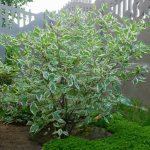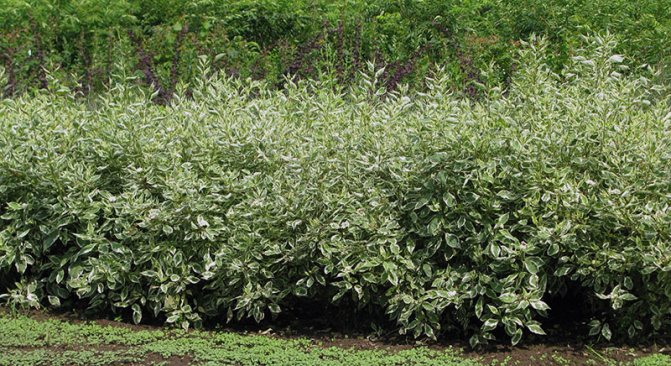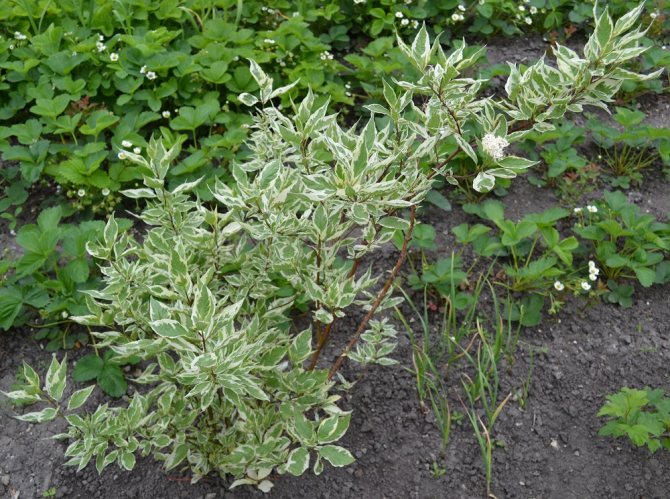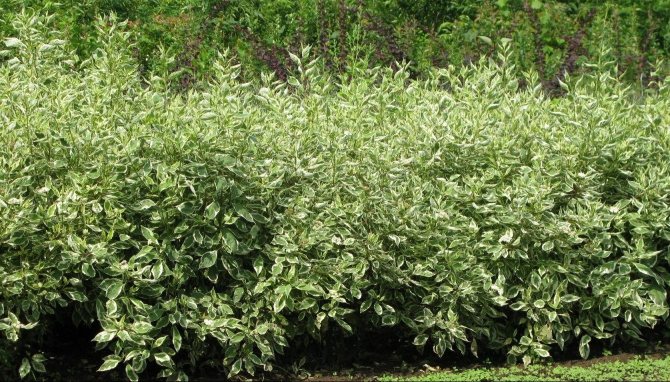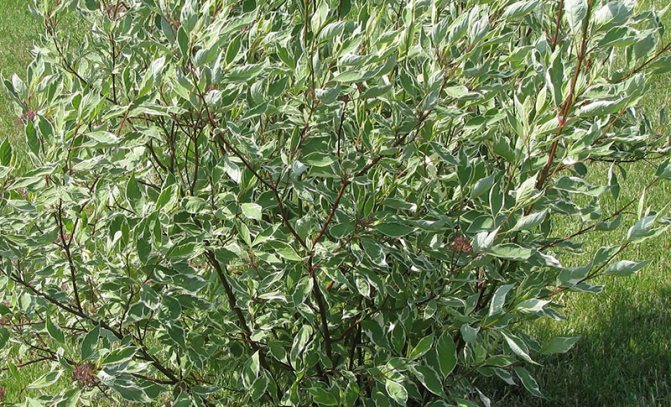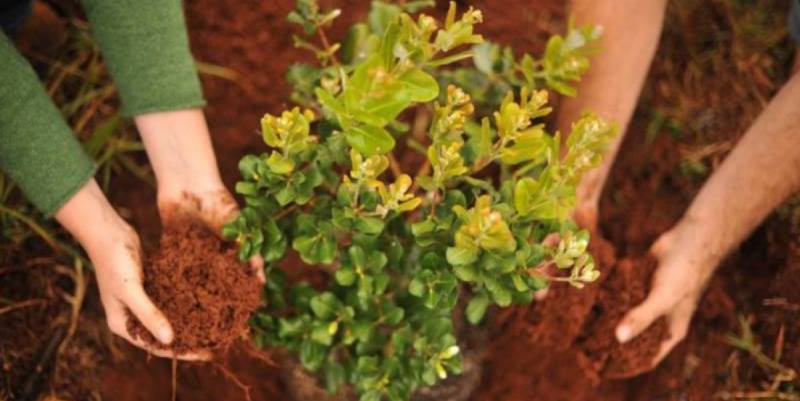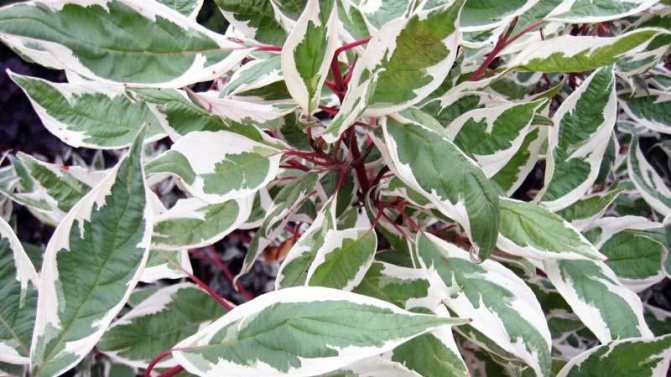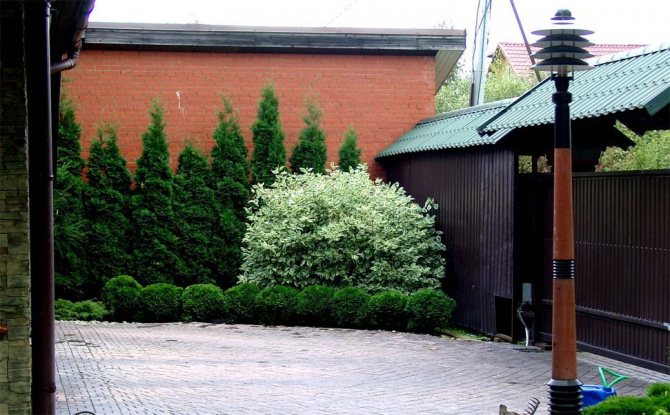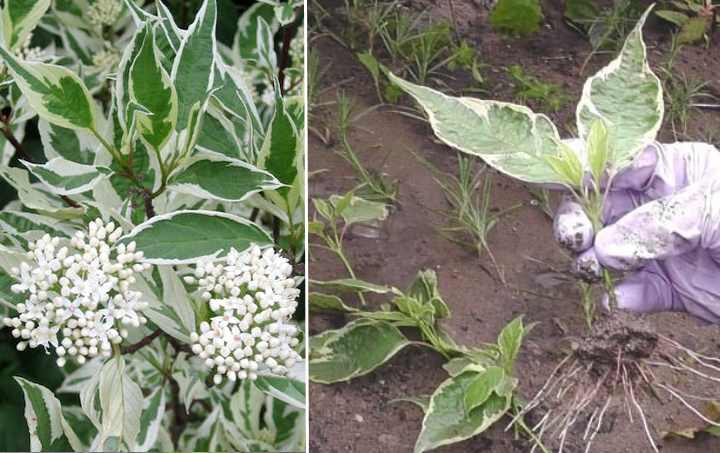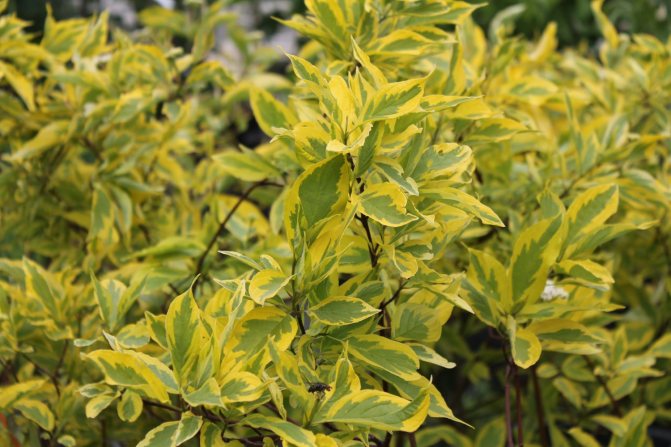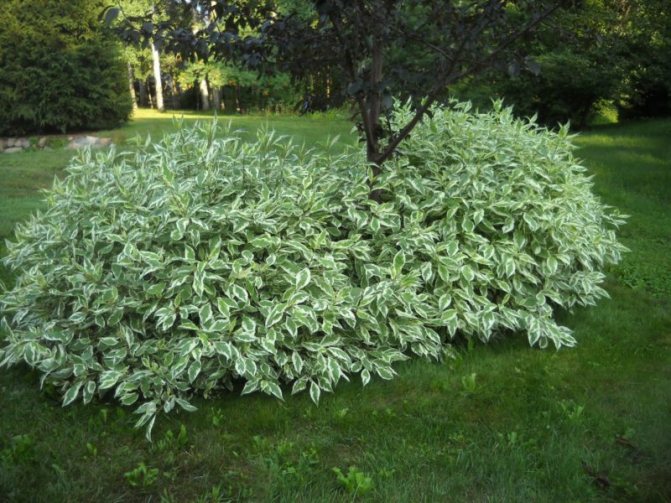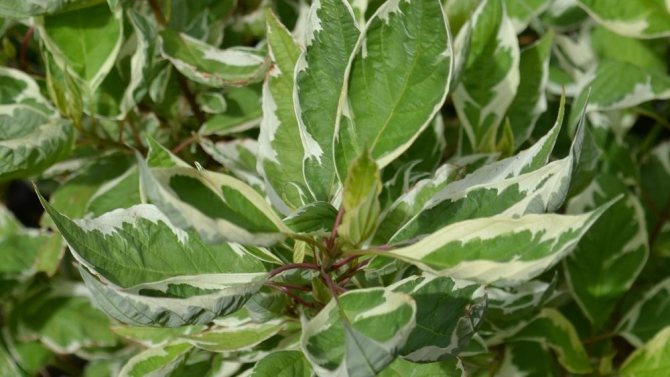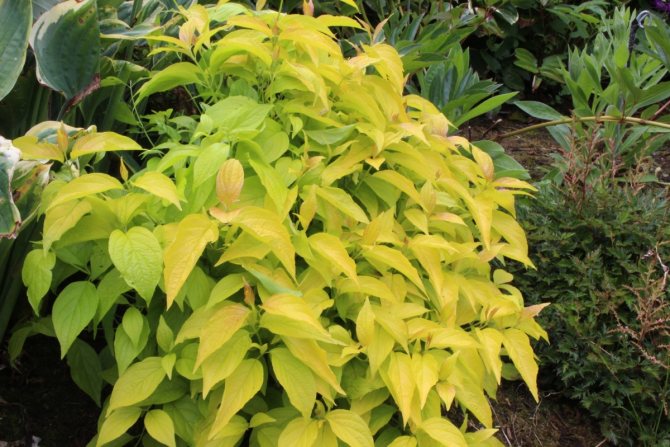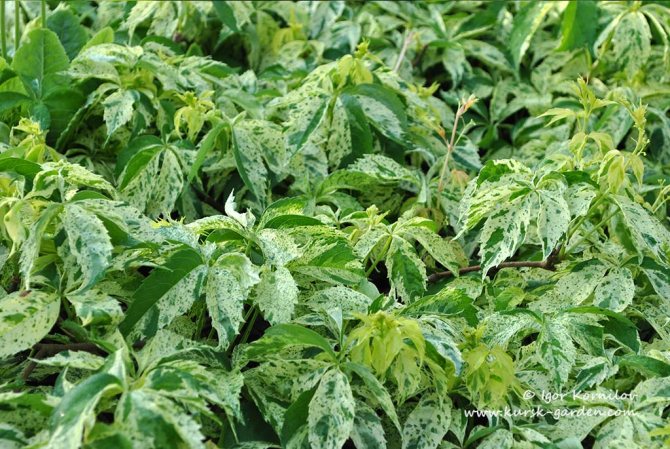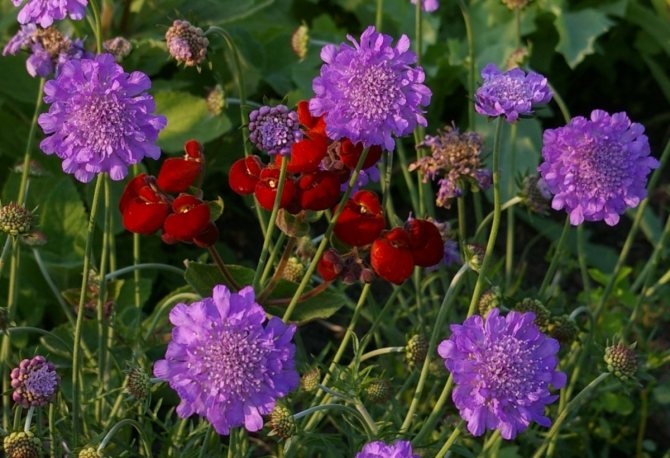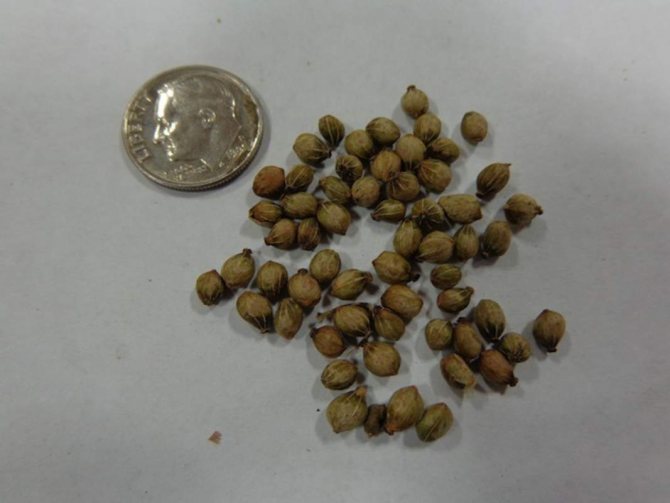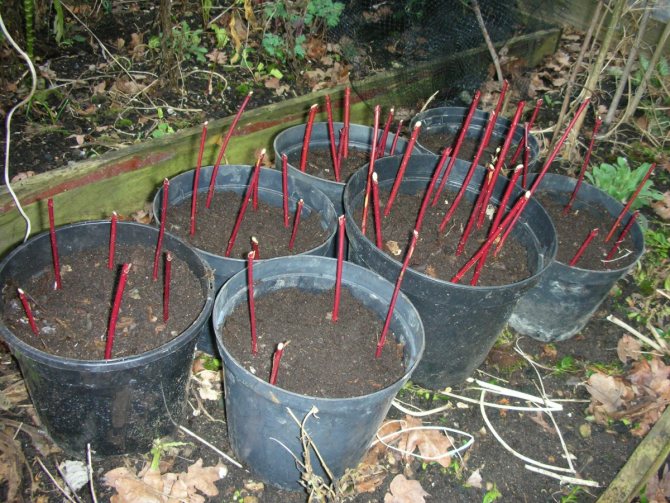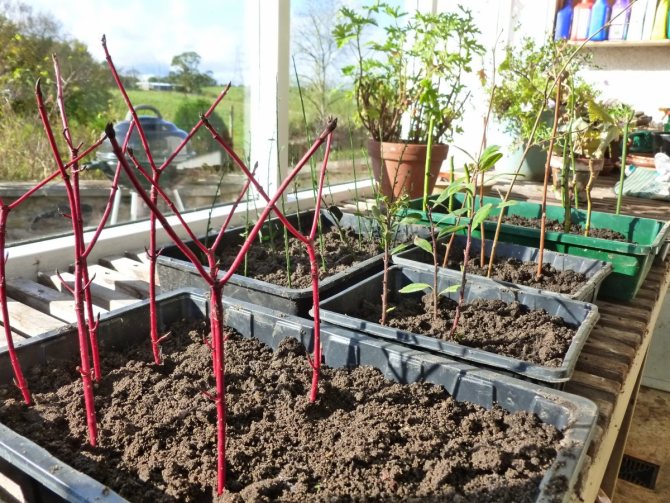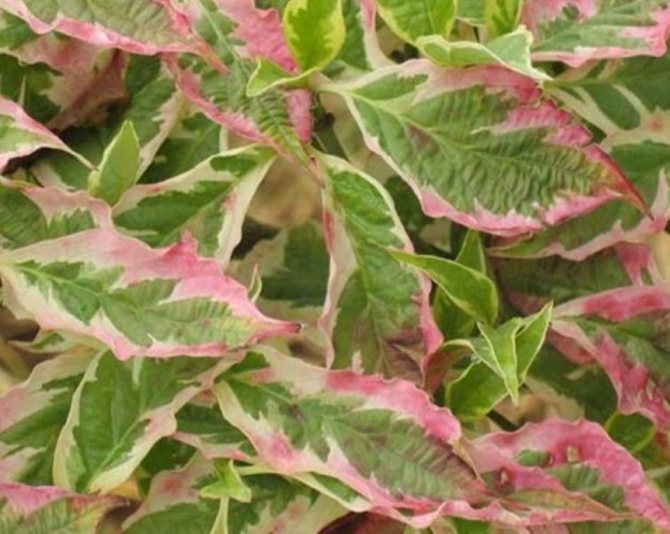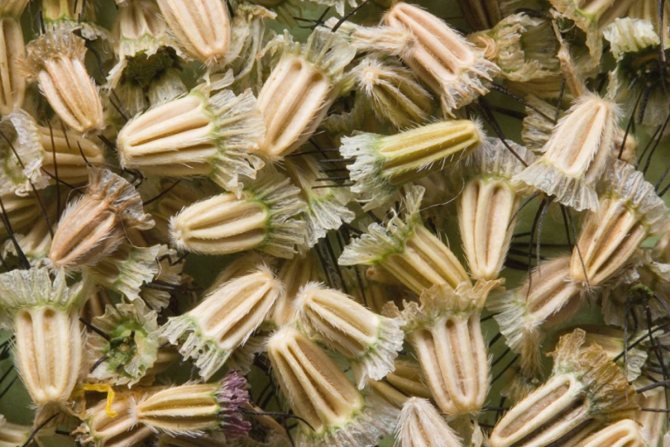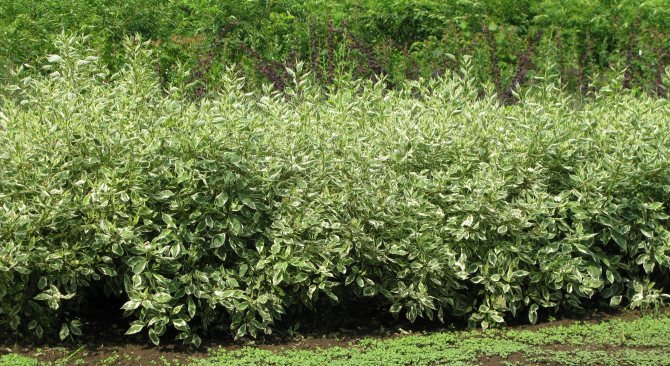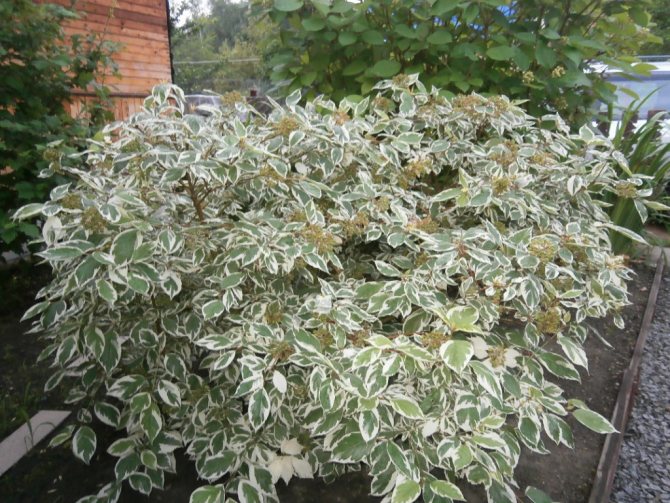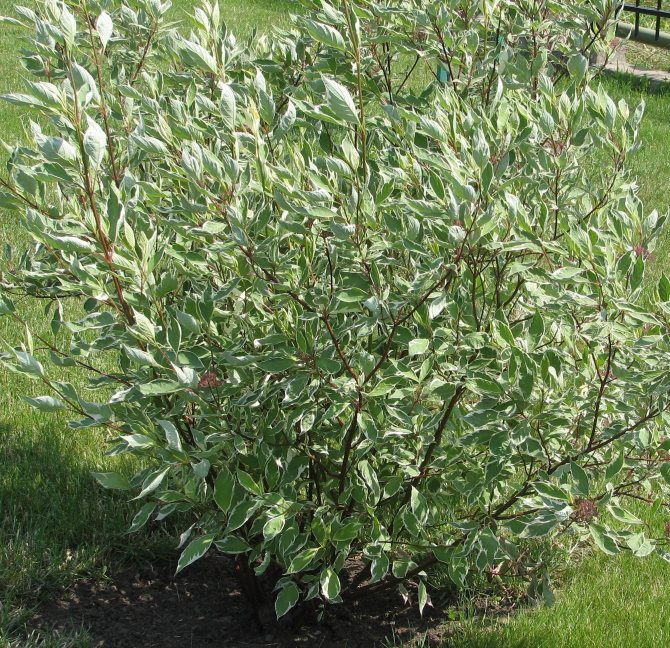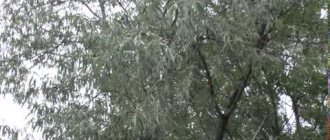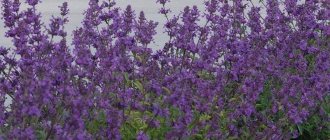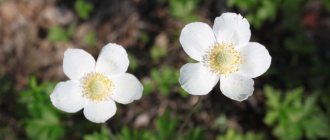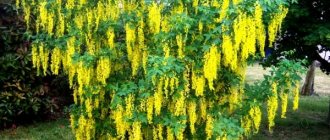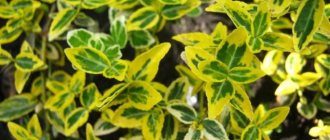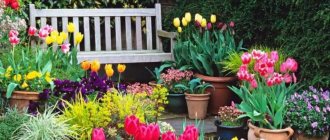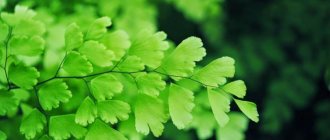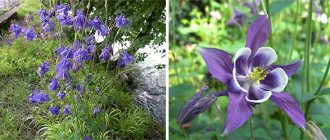At the end of May, after the flowering of rhododendrons, most varieties of lilac and weigel, the leaves finally bloom in the garden on a sow, or svidina, a unique shrub that retains a high decorative effect throughout the year. Gardeners who know the features of the shrub may well create a garden only from various types and varieties of deren, characterized by an amazing variety of shapes, sizes and colors of shoots and leaves. Three types of deren are completely frost-hardy in the middle lane: white, blood-red and scion. And there are several dozen varieties of deren.
Derain is a real chameleon shrub. Its bright red and yellow-green branches in winter and early spring go well with evergreen conifers and perennial grasses against a background of snow. Later, on the branches of the trees, no less attractive saturated green ovoid leaves with a pointed tip bloom, like those of the white “Siberian” turf or the blood-red “New Red”. The elegant Aurea variety has pale yellow leaves. Bordered and variegated varieties are especially decorative: white-green “Elegantissima” and “Sibirika Variegata”, yellow “Ayrea Elegantissima” and “Shpaety”, creamy white “Variegata”. With the onset of cold weather, the turf changes again, the characteristic colors of autumn are rich yellow, orange and purple.
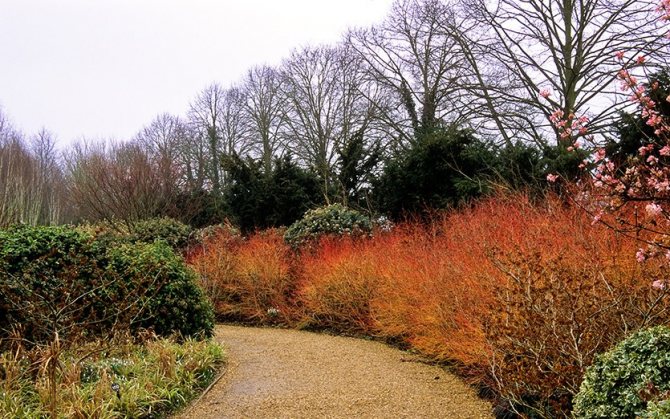
Is it obligatory to cut the grass? The answer to this question depends on the style of your garden and where the shrub is in it. In large landscaped gardens, you can leave the grass in its natural form by regularly performing formative and rejuvenating shrub pruning. In this case, in the spring, a third of the oldest branches are cut out, and ugly or too long last year's shoots are removed.
On the other hand, the lawn tolerates regular shearing painlessly, and this allows you to experiment with the geometry of the bush in the fashionable modern direction of garden design - dendroplasty, or the art of creating relief and volumes from plants. Erroneously shortened deren shoots will quickly grow back and the overall decorative effect of the shrub will remain high. It is better to start shaping the shrub in a year and a half after planting.
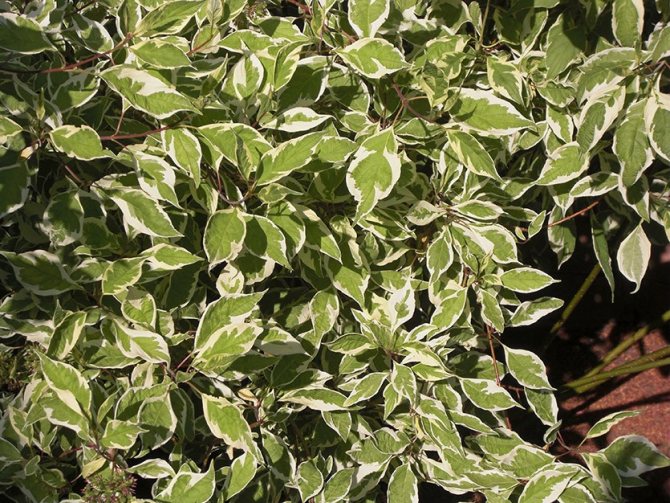

To create geometric sheared shapes, balls, cubes or hemispheres, in early spring, old (over 3 years old) and bare branches are cut out from the deer in early spring at a height of about 10-15 cm from the ground. Younger shoots and growths of the current year will serve as the basis for creating the desired volume at ground level. The shape of the bush is corrected by trimming the tips of the shoots in spring and twice in July-August, as soon as the young shoots reach a height of two or three leaves above the level of the old branches.
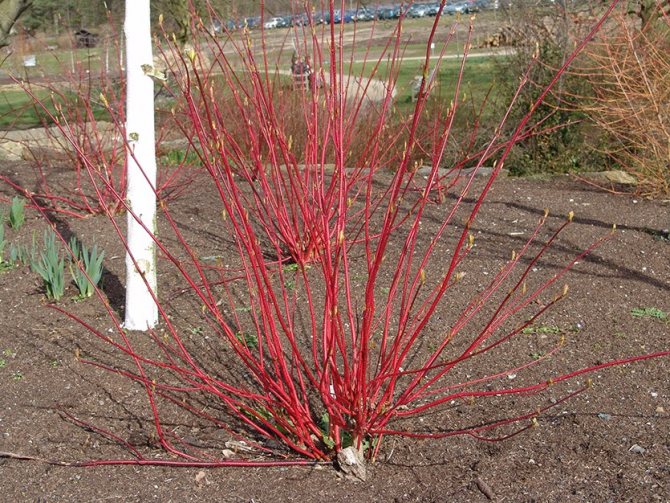

The lawn grown on a low trunk will look original in the garden. For this, one or more young powerful shoots are chosen, which are tied or intertwined with each other or tied to a vertical support. These shoots, which will become the future stem, are shortened at a height of about 0.5 m. The remaining branches are cut at the root. The crown is formed from the apical branches, regularly removing shoots on the ground and new branches on the trunk.
The variegated derens look especially interesting, from which figures are obtained not only in green or yellow, but also in bluish-white, golden-white.In some varieties in sunny areas, greens are combined with cream and pink and even red spots, for example, as in the variety "Gochaulti".
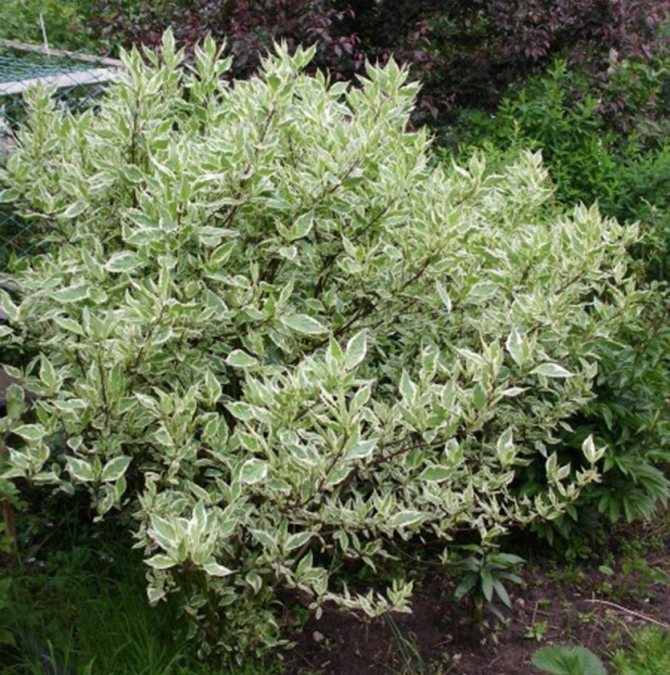

For the formation of hemispheres with a diameter of up to 0.5 m, a dwarf variety of offspring dern "Kelsi" is perfect, for forms up to 1.5 m - "Ivory Halo" dern with white-bordered foliage. Fast growing varieties will require more frequent formative pruning.
The unpretentious sodwood, a few years after planting, will become an adornment of any garden and give it uniqueness at any time of the year.
Popular publications
latest comments
HOW TO FORM A WOODEN
It is difficult to find an ornamental plant more plastic and profitable for growing than white turf (svidina). This plant has a huge variety of forms, varieties and colors, including variegated, with a rich color range.
Svidina is a great plant for beginner gardeners.
It is extremely unpretentious, tolerant of not very fertile soils, tolerates drought, lack of maintenance and partial shade. Derain grows very quickly and recovers perfectly after pruning, returning the bright juicy color of the young bark.
In order for a fast-growing plant to retain its beautiful compact shape, it must be constantly looked after, regularly pinched and cut off. The plant tolerates these procedures perfectly, thanks to its owners with beautiful decorative forms and lush foliage.
To find out how to form a sod according to all the rules, you should understand how this plant relates to pruning. Plant care depends on its species. Derens with bright bark are most decorative in the winter season. To preserve such a beautiful color of the shoots, the plant has to be completely cut out every two years. Therefore, this type of turf is best shaped as a shrub or hedge. Elegant variegated forms are attractive precisely for their foliage, therefore it is best to form them in a column or in a standard form, in the form of a small tree.
All types of trimming and shaping of the lawn are excellent. It is best to prune old wood in early spring, before the buds swell. If necessary, dry and defective branches can be cut out in winter, when they are best seen. The green growth is pinched throughout the summer.
PERFORMING WOOD CUTTING
The decision on how to form variegated dogwood is made by the owner of the plant. Derain is capable of taking any form, just some will require a little more attention than others. The plant is formed by pruning (manual or hardware) and pinching. Sharp, sturdy tools are essential for good cutting quality. The garden scissors should be sharpened before each cut to avoid tearing the thin, elastic shoots. Thick old branches with rather coarse wood are easier and more convenient to cut with a special lopper on long handles - they can easily reach the branches located in the depths of the bush. You can pinch young green shoots with your hands, scissors or pruning shears. This is the easiest and fastest procedure, but it requires regularity.
1. Natural appearance
If the garden or park is decorated in a natural (English) style, the lawn can be left to grow in its natural form. This plant looks especially beautiful in variegated form or with red-crimson leaves. However, with age, such a plant may look somewhat sloppy, so it still has to pay a little attention. All plants must undergo sanitary pruning. It includes the removal of diseased, old, damaged branches, shoots growing inside the crown and crossing with the main shoots. To maintain a beautiful shape, too long shoots of the plant are neatly pinched while still green, and, as necessary, cut off.When pruning, it is advisable to leave only one bud of renewal, so that the new shoot "looks" in the right direction.
When grown in its natural form, only sanitary pruning and shortening of unnecessarily long branches of the sod is actually carried out.
2. Stamp forms
"Colored" species and varieties of deren look great in the form of a tree. Moreover, the crown can be either natural or carefully trimmed in the desired shape.
For formation in the form of a tree, seedlings with an even central shoot are chosen, and all the rest are removed below the soil level. For this, the soil is carefully raked away from the plant and all unnecessary branches are removed. If you cut out shoots at ground level, then this will stimulate the active growth of new shoots and the standard form will be quickly lost. Nevertheless, you need to be prepared to periodically remove the growth that appears from the ground.
From the remaining central shoot, which should become the trunk of the future tree, side shoots are removed to the height of the desired trunk. Shoots are cut out on a ring, leaving no dormant buds. If necessary, the sections are covered with garden pitch.
The upper part of the crown is formed at will. It will have to be trimmed regularly (at least twice a summer), as well as pinching and sanitary pruning.
3. Arches and semi-arches
Derain forms long, very flexible shoots at a young age, which can be formed in the form of beautiful arches or semi-arches. For this, shoots of a suitable length are bent and fixed with stretch marks and twine. Over time, the plant gets used to this position and retains a fixed shape.
From two rows of svidina, planted on the sides of a narrow path, you can form a beautiful arched alley. For this, the crowns of plants are connected in pairs into an arch at the desired height.
You can form svidina in the form of beautiful slender columns, and give them the shape of a cylinder, candle flame or square in cross section. To create such decorative forms, a plant grown from a cuttings is suitable. They begin to form a column from the second year after planting, stimulating the growth of shoots upward and the formation of a dense bush. To do this, all lateral shoots are regularly pinched or cut at a certain distance.
5. Decorative haircut
Like many other plants, the grass can be cut in a variety of decorative forms. You can get spherical, cubic, hemispherical plants, give them an oval shape. Such a decision will require more attention from the owners, since a clear shape is maintained by a constant haircut.
Most often, undersized bushy varieties of deren are sheared in the form of a hemisphere. It is not necessary to observe a clear geometry, it is enough to give a neat shape without separate branches sticking out to the sides. Such svidina forms a lot of foliage and looks very elegant, especially colored and variegated varieties. Hedges
The formation of hedges will also require regular haircuts, the purpose of which is not only to give a clear, regular shape, but also to form a thick, dense bush. Hedges are cut with garden shears or hedge trimmers, approximately in June - early August, 2-3 times per summer. It is advisable to prune the plants when the growth reaches 10-15 cm above the level of the previous haircut, then pruning is easier.
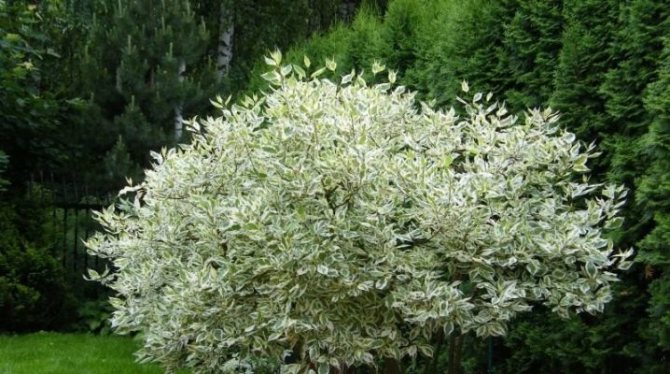

Derain variegated is an ornamental plant that is rapidly gaining popularity among the owners of private houses and cottages. It looks very impressive, so the culture is often used in landscape design, and the shrub is attractive both in summer and winter, and besides that, it is unpretentious and resistant to the most difficult climatic conditions.
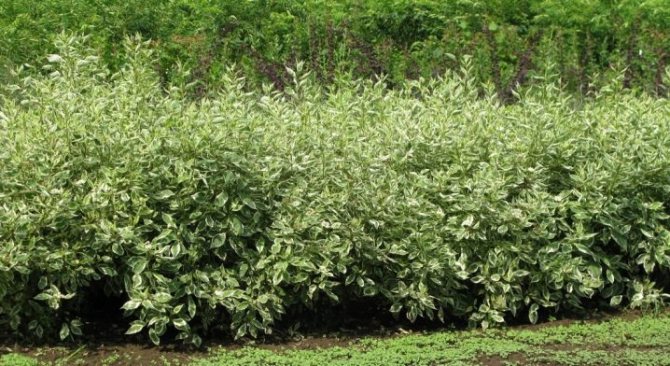

Planting a plant
In order to plant a plant and at the same time not harm it, it is better to perform all the manipulations in the spring. This season is distinguished by the fact that the soil is already warmed up enough, so this soil is very suitable.So, the shrub will have several months to germinate, get stronger and prepare for winter.
For planting, you should choose a young, healthy plant, with bright leaves without visible defects. Dogwood is most suitable, which is no more than 3-4 years old.
When swampy soil is selected, the planting hole must be deepened a little more and drainage laid. During planting, organic fertilizers (humus, compost) are also indispensable.
If the root system of the plant has dried up, it is better to first put it in not very cold water for several hours. After all the manipulations, you can plant dogwood on the selected area of the soil.
Dogwood variegated: choosing a place for planting
Dogwood is a rather unpretentious bush, but the place for planting it should be chosen based on the characteristics of the variety. For example, shrub species with brighter leaves will grow better on the sunny side of the garden, while being in the shade will completely change its color to a uniform green. However, the lack of bright light does not affect the growth and development of turf.
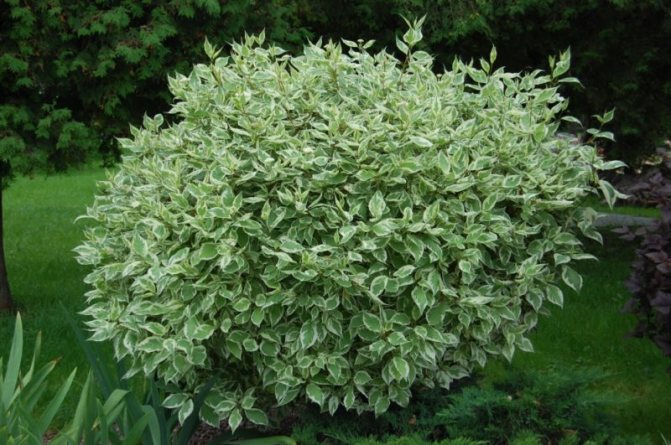

It is not recommended to plant a bush near other plants and, moreover, trees. This is due to its high growth rate and spreading branches.
The most suitable soil is one that will pass water well - sandy or sandy loam. It should be loose, airy and fertile, in such an environment the dogwood will feel most comfortable.
Transplanting an adult turf
Transplanting should be done only in extreme cases, as this is very stressful for an adult shrub. That is why the choice of a place for the first landing should be approached with all responsibility.
When you can't do without a turf transplant:
- finding a bush in the shade, loss of a variegated pattern on the leaves (if this was not the original goal);
- heavy, clayey soil;
- being close to other spreading plants or trees.
Unlike the first planting, an adult shrub is transplanted in late autumn. At this moment, the dogwood sheds its leaves, thanks to which acclimatization in a new place will take place for it with the least stress. Early spring is also suitable, when the buds have not yet swollen.
It is necessary to dig out the plant carefully, trying not to damage the roots, it should be transferred along with the earth lump. The borders of the rhizome grow parallel to the crown. The transplanted dogwood is recommended to be thoroughly watered and fertilized. At first, you need to water the bush daily.
Transplanting an adult plant
Transplantation of an adult deren takes place when:
- wrong choice of the initial place (too dark, humid, little space);
- dry and poor soil composition;
- derain drives out neighbors.
In this case, variegated dogwood is transplanted in the fall, after the end of the growing season. If there is a need for a transplant in the spring, then the procedure is carried out before the appearance of the kidneys.
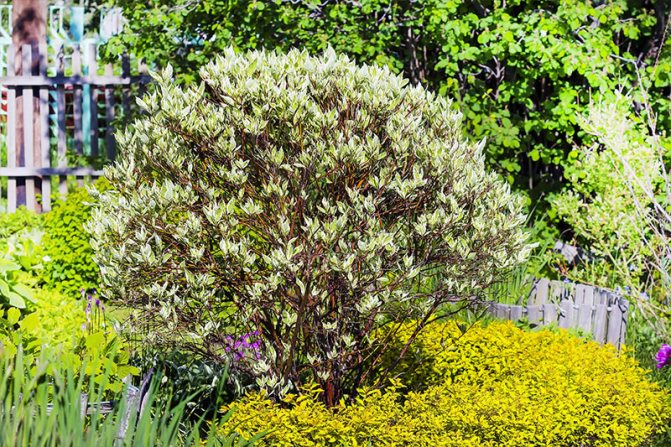

They must be planted with an earthen lump according to the algorithm described above.
How to propagate variegated dogwood
Variegated turf propagation is carried out using seeds, or by layering, cuttings or dividing the shrub. The first method is the slowest, but quite effective, the rest of the options are suitable for quickly getting a new bush.
Seeds
Planting seeds is the most painstaking breeding option for this shrub. The gardener will be able to evaluate the result only after a few years, when the plant reaches its natural size. That is why this method is not suitable for most lovers of beautiful landscapes.
Basic principles:
- Seeds are recommended to be taken from an adult plant from 3 years old.
- Planting is carried out in winter, in frozen soil.
- If the spring period is selected for sowing, it is necessary to pre-harden the seeds at a temperature not higher than 5 degrees for a couple of months.
- When planting, seeds need to be deepened into the ground by a few centimeters.
This version of turf propagation is distinguished by high percentages of plant germination, but it is the most laborious.
Propagation by cuttings
Another way to get a beautiful garden design in a short time is to propagate turf by cuttings. This option helps to preserve all the characteristics of the mother bush in the daughter.
How is it done:
In the spring, pruning of the shrub is carried out, then it is necessary to select shoots suitable for reproduction. They must be healthy, strong, and have several large buds. The cuttings should be planted in a container with enriched soil, then placed in a greenhouse.
The shrub will take root all summer long, during which it must be fertilized and watered regularly. In early autumn, prepared seedlings can be planted in a selected location outdoors.
Dividing the bush
The option in which reproduction is carried out by dividing the bush is quite simple.
How to do:
Mature variegated dogwood should be dug up with the root. Then the shrub is divided into components, the root system is divided with a knife. After all the manipulations, the plant is planted back, the daughter seedlings should be transplanted into pre-selected, prepared and fertilized depressions in the soil.
Reproduction by layering
Due to the fact that the shrub has spreading foliage, such a method as propagation by layering is also suitable for it.
How is it done:
Held in the spring. To do this, it is necessary to bend the young branches to the ground, securing them with metal brackets. Shoots should be sprinkled with soil, watered. Over the next year, the shoot will take root, and next spring it can be replanted.
Spire pruning (pictured)
Some of the most popular shrubs are spireas
... They have a lot of advantages: they bloom beautifully, are unpretentious, frost-hardy, have many types and garden forms.
Spireas are divided into two large groups: spring and summer flowering.
The first ones bloom on the shoots of last year, and their flowers are mostly white, collected in umbrella-shaped inflorescences. Cut off the bushes immediately after flowering, completely removing shoots older than 5 years.
If you trim a spring-flowering spirea (Wangutta, gray, nippon, etc.) in the spring, after flowering, it will give a large number of shoots, which next year will also delight you with abundant flowering.
If you cut it in the second half of summer, you will not get flowering next year. Or get so weak that it makes no sense to keep it for the sake of flowering, just for the sake of form. And these spireas are formed perfectly: if you want it with a ball, you want it with a cube.
Or you can create a beautiful curb or hedge out of them. Summer-flowering spireas (Bumalda, Japanese - ‘Little Princess’, ‘Golden Princess’, ‘Shirobana’, etc.) bloom on the shoots of the current growth. They can be cut as you like and whenever you want, they will still grow and bloom, albeit later, but will give you the decorative effect you want. The more often you prune summer spireas, the more compact, thicker and fluffier they become, but the less they will bloom. Therefore, it is better to cut the bushes after flowering or in early spring, cutting very shortly - 15-30 cm above the soil surface.
From the buds remaining on the stems, strong young shoots grow, on the tops of which, by the middle of summer, bright flowers (most often pink or red) bloom, collected in large corymbose or paniculate inflorescences.
Caring for variegated dogwood
The beauty of the leaves, as well as the general appearance of this plant, directly depends on regular care, which is based on two basic rules: periodic enrichment of the soil and timely pruning of the crown of the bush.
In general, variegated dogwood is quite unpretentious, tolerates heat or cold well.The main growth of buds and shoots occurs at an air temperature of 15 degrees, if it is lower, the shrub sheds its leaves, preparing for winter.
Watering and feeding
Young, newly transplanted turf shoots should be watered sparingly every day. Bushes that are older than 3 years do not need daily watering; in the summer, the schedule fluctuates between 1-2 times a week.
If the soil around the shrub is wet, watering should be skipped during this period. One bucket of water is enough for an adult dogwood.
The shrubs are fed in spring and summer, using mineral (200 grams per bush) and organic (5 grams of compost per plant) fertilizers.
Pruning
Pruning is necessary to give a beautiful shape to the bush, as well as for basic caring for it. It is necessary to trim twice during the summer, during which wilted leaves and dry branches should be removed. For these purposes, it is recommended to use a pruner.
With turf, you can create a clear border in the form of a hedge or a beautiful, single, round plant. Pruning should be done carefully, trying not to damage the leaves, which are the main advantage of the variegated shrub.
How to provide proper care for the plant?
As mentioned earlier, svidina will delight you with ease of care and its unpretentiousness. Mulch the soil near the plants with organic materials. Do not forget about timely moderate watering during dry periods, loosening the soil, and weeding. Pruning is an equally important point in caring for white turf.
Pruning deren before wintering
The nature of this procedure will depend on the climatic conditions of growth and on your personal preferences. If you want to contemplate beautiful red shoots in the winter season, then prune in early spring. In this case, you should cut off the branches near the ground. Over the summer, the shoots will have time to grow. Such trimming of the deren will contribute to its greater splendor, however, it will reduce the abundance of flowering and the number of berries on the plant.
If you like its flowering and growth in height more, then carry out the formative pruning in the fall. Just shorten the svidina branches to the desired height. Such trimming will contribute to a neat appearance and a harmonious shape.
Advice. To renew old, overgrown plants, it is necessary to prune to the very root every few years.
Preparing the turf for wintering
Since the plant is quite unpretentious, it does not require special preparation for wintering. It is recommended to leave young cuttings in a greenhouse in temporary soil until spring; an adult plant does not need additional manipulations.
In the fall, you should reduce watering and fertilization of the soil. Before winter, the bush will completely shed its foliage, which will help it survive the cold season.
Variegated dogwood is very easy to care for with its obvious beauty, making it a favorite among many gardeners. He is able to ennoble any garden, pleasing the eye with his two-tone crown for many years.
Derain variegated in landscape design is used a lot and often. It is an ornamental plant, the colorful colors of which will adorn the territory all year round. People have used these trees and shrubs for a long time to create a unique environment around their home. This culture is pleasing to the eye and promotes relaxation after a busy day at work.
The shrub usually grows no higher than 3 m, the tree - up to 8 m, and takes 2-5 m in width (depending on the species). This must be taken into account when landing.
Briefly about the features of the deren
Variegated turf shrub is a fairly common garden and park plant used to decorate parts of a garden or park, form green fences, etc.
Derain variegated is sometimes called Swida, white telikrania.The deren shrub does not grow higher than 3 meters, which makes it very convenient for the formation of hedges. The dense foliage of this tree will reliably hide the area from the views and even the penetration of small animals. The most widespread variety of deren is called "Elegantissima", the seedling of which you can buy in our nursery.
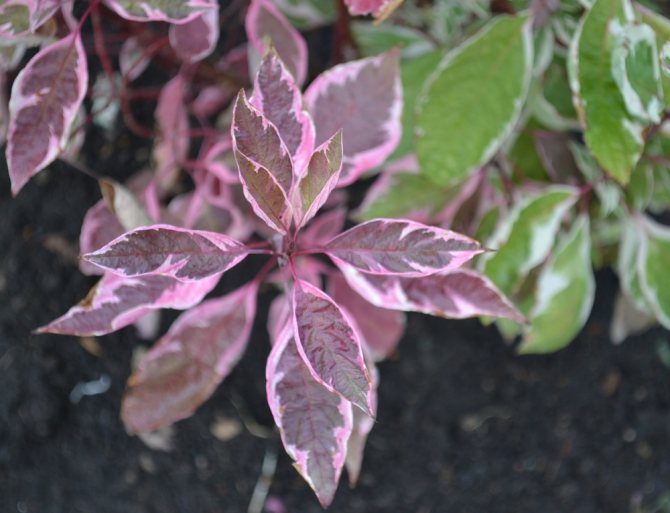

In addition to the low growth of the grass, it also differs in unusually beautiful foliage. Bright variegated foliage with a white border will persist until the first frost, and closer to autumn, the color of the foliage can acquire a reddish tint, which looks very impressive and unexpected. The border of deren leaves in different varieties can be white or yellow.
Garden decoration
There are about 50 species of variegated turf. This unpretentious plant can take root in both shady and sunny places. The best option is partial shade. In most cases, it is frost-resistant. Any soil is suitable for planting it, but acidified is better, with the addition of lime. It is not recommended to plant it in sandy and clay soils. Deren should be planted in a free area of the garden, away from tall plants and conifers. With proper planting and sufficient watering, it grows rapidly.
Derain variegated will decorate any landscape. The combination of bright leaves with an unusual bark color makes this plant very beautiful, capable of enlivening any landscape at different times of the year. In winter, against the background of white snow, the branches of the deren, painted in red or orange, look very impressive. They also revive the site in early spring. Some varieties bloom during this period, being a wonderful decoration for the garden, which begins to awaken after winter. In summer, the dogwood is pleasing to the eye with its variegated foliage, and in June most of its varieties bloom in small bunches of flowers. But in the fall, the plant will show itself in full glory, lighting up the garden with bright colors of leaves, complemented by shades of berries of ripe fruits.
Plant varieties
There are also evergreen varieties of variegated turf, they are unpretentious and resistant to frost. This shrub works well with other plants and is often used as hedges and curbs. To maintain and form a beautiful shape, the culture must be regularly trimmed, as well as dry and excess branches removed. Usually this is done when the plant reaches 3 years old, regularly 2 times a year (in spring and autumn), and if necessary, then several times a season. If this is not done, then the shrub will look untidy. Derain is used both in group compositions and separately.
The most popular type that is used in landscape design is white turf. It reaches 3 m in height and up to 5 m in width.
The color of its leaves is dark green, even bluish, and in autumn they turn yellow. The bark is dark red, flowers and fruits are white. The plant blooms 2 times per season (in early summer and autumn). Able to reproduce independently: the lower branches, in contact with the ground, give roots and grow, forming new shoots. This type of turf needs regular cleaning of old and dry branches.
Chinese Derain grows up to 7 m in height and up to 4 m in width. It pleases with long flowering in summer, and in autumn illuminates the garden with amazing colors: the leaves turn bright red with pink or white tips. This type of deren does not tolerate frost and cold winds.
Stunted species
Low-growing varieties of variegated deren are used to revive the color of stones in alpine hills, and are planted under the crowns of trees in the garden. Derain is able to inhibit the growth of weeds and create a variegated carpet that adds beauty to the garden. Ground cover types of deer can successfully replace lawn grass.
The representative of undersized plant species is the Canadian turf. The height of this plant does not exceed 15 cm.It is decorated with snow-white flowers in spring and red berries in autumn. And all this against the background of dark green leaves. This species loves shady corners of the garden, well-moisturized acidified soil. Covers the surface with a dense carpet of foliage, which hibernates well under the snow. It harmonizes well with ferns, dwarf flowering perennials and miniature trees that are adapted to life in the shade.
Plants that are easy to care for
Derain variegated - a representative of the genus dogwood. Cornelian cherry grows up to 7 m in height, blooms in early spring (before the appearance of leaves), small yellow flowers.
In autumn, it pleases with fruits that are not only beautiful, but also edible. The plant is very easy to care for: in the spring it must be cut and cleaned of dry branches.
If you decide to use derain in landscape design, then you will never regret it. Any of the species of this plant will delight with its unique beauty. It is important to remember that this species can be propagated by seeds, cuttings, layering and seedlings. Planting the prepared material is carried out in the spring. It is important to take into account that there must be enough free space between the seedlings for their growth. In the first year of life, the dogwood needs frequent feeding with complex fertilizers. In the first winter, the plant must be wrapped from frost, but not too much so as not to overheat. Derain is resistant to disease, but aphids and fungal infections can harm it. Therefore, it is necessary to inspect the plant, prevention and timely treatment. In gratitude for the care, the culture will respond with a variety of bright colors.
White turf, numbering over 20 different species, is a very common horticultural crop in Russia, like many others. The most famous types include the following varieties:
- Elegantissima, which is considered one of the most famous winter-hardy shrubs, growing up to 3 meters in length. The leaves of this white deren are bluish-green with white edging. By autumn, they become slightly pinkish.
- Siberia. A beautiful shrub about 1.5 meters high with coral branches and lush green foliage. We emphasize the beauty of the bark of the plant, which has a bright red hue, which looks contrasting in winter - a red spot surrounded by snow-white snow.
- Aurea growing in length up to 2 meters. Among all varieties, it has the widest leaves. This variety blooms with small creamy white inflorescences.
- Shpet. A beautiful shrub with a height of about 2.5 meters. Has a beautiful spreading crown. The shoots are red, and the foliage pleases with bright golden stripes and border.
- Cream Cracker capable of growing up to 3 meters in height. The shoots of this variety are purple-red, the leaves are light green. And this white tree blooms with inflorescences of a delicate cream color.
This plant is very unpretentious, which is a huge plus for novice gardeners. The shrub does not have any special requirements for the soil (it grows well and takes root both on sandy and loamy soils), calmly tolerates drought, severe frosts, is resistant to many diseases and is not particularly attractive to insect pests
.
White turf in the garden
And yet, despite this, you need to carry out some activities during planting and further care. You should start from the place where the deren was planted:
- In sunny areas, white turf develops faster, and its leaves acquire juicy bright colors.
- It is advisable to fertilize the soil poor in useful microelements before planting the shrub - this will allow the shrub to quickly take root and get used to the new place.
- If your site is near a reservoir, be sure to drain it to prevent rotting of the root system of the shrub.
It remains to find out how the planting of seedlings is carried out.First of all, the purchase of plants in spontaneous markets, that is, from hand to hand, threatens you with the purchase of a white turf not at all of the variety you expected. Therefore, it is better to spend a little money and buy a seedling in the nursery.
The second point is always inspect the young tree before buying. The bark must be clean and free of damage. In addition, it is better to purchase a 4-year-old seedling - such shrubs take root and take root much faster.
4 year old deren sapling
Instructions:
- Having determined the planting site for the shrub, we dig a hole slightly larger than the diameter of the earthen coma.
- Pour a nutrient mixture into the hole, which should consist of leafy earth, humus and mineral additives. Since a shrub can grow in one place for a fairly long time (about 25 years), at the beginning of growth it is necessary to provide it with adequate nutrition, and only after that add additional feeding.
- We fill the hole with the plant with soil, tamp it and water it well.
If you are planting in the fall, you do not need to do anything else. But when planting in spring, be sure to mulch the shrub, which will avoid moisture loss.
So, only young plants should be watered regularly, and adults should be watered with high quality only on the hottest summer days. Seedlings need to be watered every day during the summer, and mature bushes only once every two weeks. Approximately 20 liters of water is added under each plant. You do not need to feed white turf if you have done good soil preparation before planting. But if you want to make the flowering of the deren more abundant, and the leaves - bright and juicy, you can feed the shrub twice a year.
Blooming white deren
In the spring, add mineral fertilizers to the soil (about 200 g for each bush), and in the summer use organic matter (5 kg of compost or chicken manure for each plant). The most important activity is pruning. White turf is remarkable in that you can work the most real miracles with its crown, turning it into a beautiful shrub, which will become a wonderful element of your garden. Follow a few of our guidelines:
- Arm yourself with a sharp pruner and saw.
- Remove old and diseased shoots.
- After that, we remove the ugly growing branches that interfere with the decorative formation of the crown.
You need to maintain a beautiful bush crown all year round. Having started this process, you will have to form the crown for a long time and painstakingly in the future. The only time when work should not be carried out is winter. When cutting off a large number of branches, you should not worry - the shrub will very quickly start up new shoots.
You can decorate a garden plot with such an amazing plant like a dogwood. In order to have beautiful plantings in the future, you should study the methods of reproduction in order to breed the plant yourself. With turf, problems and difficulties will not arise due to unpretentiousness and many breeding options.
Derain grows rather quickly, regardless of growing conditions. Cases have been recorded when a plant rooted on its own, using it as a support for other plants.
Pruning hydrangea
Panicle hydrangea can withstand a fairly strong pruning. But if you cut it every year, it starts to wither. Especially if it is in shade. Therefore, you should not be zealous with panicle hydrangea. Cut off faded inflorescences in the fall. Feed with autumn fertilizer, mulch with compost or humus.
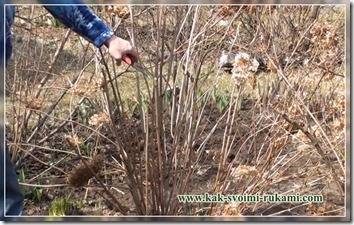

And if you need to radically rejuvenate, then it is better to do it in the spring. It is possible on the falling snow, on the already swollen buds. As with the turf, trim it internally to form a lower dome, whatever height you want. And be sure to feed with mineral fertilizer marked "spring" so that it can quickly build up its mass instead of the lost one.
On a note
The deren, in contrast to the spirea, has a rather long internode.In a spirea, wherever you cut a branch, be sure to get close to the bud, from which the shoot will then start and begin to branch. Derain is best cut at a distance of 0.5-1 cm from the knot. Then it overgrows easily and looks decorative. Otherwise, you will get a bush or hedge with dead stumps.
The same applies to other shrubs with long internodes (bladder, mock orange, etc.).
Derain as he is
In total, 4 subgenus of this plant can be distinguished in nature:
If the goal is to breed a large amount of white turf, then the propagation method is most often used by cuttings. Cuttings are selected with a height of 10-158 centimeters, and only from mature wood. The output will be almost 100% rooting. When using green petioles, rooting will be very weak, up to 30%.
Subtleties of collecting cuttings:
- The optimal time for collecting material is the first days of July. The twigs should be from last year, very flexible, the wood is ripe.
- Shoots in favorable conditions grow rapidly and actively develop, which makes it possible to propagate cuttings in water.
- The twigs are selected from last year, which are quite woody.
- There should be two internodes on the petiole, the leaves are cut from the bottom, the upper ones are shortened. The forces of the plant will not be spent on feeding the foliage. In this case, moisture evaporation will be significantly reduced.
- Small pieces of paper can be saved.
- The petioles are placed in a container so that the lower buds are completely immersed in water.
- A week after immersion in water, the first roots will begin to appear.
When rooting turf by grafting, it is important not to miss the time of planting in the ground. Young roots are very fragile and brittle, they can easily be damaged during disembarkation. In this case, the plant will die after a short period of time, or it will be sick for a long period.
When the roots are one centimeter long, young plants should be transplanted. Then they will quickly take root, will be strong and healthy, and active growth.
Another good way to root is planting in a cold greenhouse. The cuttings are seated in rows, keeping a slight slope. Watering is regular and mandatory. Both excessive moisture and drying out of the soil will be harmful.
In dry and hot periods, the greenhouse needs shading. The planted cuttings are constantly sprayed. By September, the seedlings will have formed roots, but it is not yet worth replanting them to a permanent place.
Cutting is exactly the propagation method that is suitable for many varieties and species. The easiest way is to multiply. It is unpretentious and easy to care for. Cutting allows you to keep the variety unchanged, that is, the decorative sod will be an exact copy of the mother plant. By propagating by seeds, such a result cannot be achieved.
With successful reproduction, already in the fall the gardener will have a large number of young and strong seedlings. But it is not recommended to plant them in the same year; it is better to postpone the procedure to next spring. If you plant a young plant in the same one, it may not survive the winter, frosts will have a detrimental effect on development.
Cuttings that have been rooted in water are planted in a greenhouse. For the winter, greenhouses are well insulated. You can plant cuttings in boxes, and put them in the basement.
In the spring, plants can be transplanted to a permanent place in open ground.
When the grafting process has come to an end, you should start planting seedlings in open ground. The procedure can be carried out immediately to a permanent place, but experts recommend planting cuttings in a previously allocated area. It is here that young sod grows stronger and grows.
Transplanting the grass according to these rules, in a few years it will be possible to observe the formed and beautifully blooming hedge.
When planted in the ground, the cuttings are not deepened much, and additional roots are formed on them, which in the future feed the flower. A spacious hole is dug so that fertilizers can be added to it. They will feed the plant for a long period. If variegated dogwood is planted, then it is not recommended to fertilize it. From a large amount of feeding, flowers can grow in the same color, and the decorative image will be lost.
To divide a bush, you should choose a strong and healthy plant. In this case, the derain should grow sufficiently. The rhizome, on which there are processes, can be divided into 2-3 parts, sometimes more.
The procedure for dividing the bush is carried out in the spring in this way:
In white turf, the crown is often spreading, and the branches descend to the very ground. At the same time, an independent merger with the soil will not occur; the intervention of a gardener is needed here.
So that another plant is obtained from the layering, the engraftment procedure is carried out in the spring. The dropped branch is pinned to the soil (you can use a metal bracket for this). The place of digging is covered with mulch or a small layer of earth.
The next year (autumn or spring), the seedling can be dug up and transplanted into a new, previously prepared hole. During the year, a fairly good root system is formed on the twig. Such a plant quickly takes root in a new place.
Reproduction of the svidin shrub
Derain variegated (svidina) is easiest to propagate using cuttings. Cuttings are cut in the fall and stored in a cool place (cellar) until spring. To prevent the cuttings from drying out during storage, it is advisable to cover them with wet sand.
But it is quite easy to get new svidina sprouts by layering. In the spring, dig in a long lower branch and after a few weeks new shoots will sprout from it. When the root system is formed, divide the dug-in branch into sections with shoots and transplant them into separate holes. It is advisable to do this in the fall or spring.
Since the turf blooms and forms seeds, it is theoretically possible to grow a turf bush from seeds. Seeds collected in autumn are stored in a cool place (approximately +5) and sown in open ground in spring. The seeds will sprout, if they take root, only after two, three years.
How to care for a planted plant
Derain is quite unpretentious, it grows quickly. The main thing is to water the plant on time. This is especially true for newly planted young plants. The hot summer sun will have a detrimental effect on them, especially with a lack of moisture.
In a dry season, with a lack of water, the leaves of the plant will wither, and it will lose its decorative appearance.
It is advisable to water it after sunset, while the soil should be moistened well enough, about 50 centimeters deep. Many gardeners make a hole near the trunk circle, and fill it with water with a hose. If the plant has time to wither, then abundant watering will bring it back to normal. An already mature shrub will require about 35 liters of water. During the season, there should be at least 4 such waterings.
To preserve moisture near the plant, it is recommended to sprinkle the watering hole with peat a little, and mulch it well. A solid layer, 4-6 centimeters, acts as a protection against overheating, moreover, the weeds will grow many times slower. The optimal time for mulching is mid-spring, when moisture is still inherent in the soil, but the sun's rays have already warmed it up enough.
For the density of the crown, fertilizers are applied under the bush several times a year. Mineral dressing will promote active growth. It is recommended to introduce them during the period of growth and development of new shoots, that is, in early summer or late spring.
If the grass grows slowly and develops poorly, nitrogen fertilizers will be needed. They will also have a positive effect on branching.
Potash fertilizers are applied in the fall - this will improve, so to speak, immunity, the dogwood will be less susceptible to diseases, and frost resistance will improve. This is especially true for variegated varieties.
How to buy Derain variegated in our nursery
You can buy one Derain plant from 200 rubles. We send plants and flowers to nonresident customers by mail.
A short description, as well as other photos of this shrub, were taken in our nursery during different periods of growth of this plant, you can see by following this link: Derain variegated Elegantissima.
Description and recommendations for growing other plants:
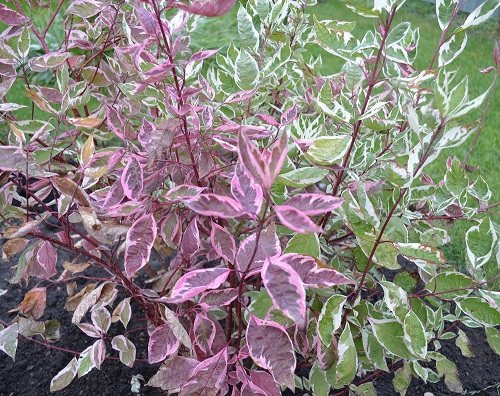

Derain white Siberica
In our nursery you can buy deren saplings of different varieties, including the Siberica variety. We send deren saplings by mail only in spring and autumn.
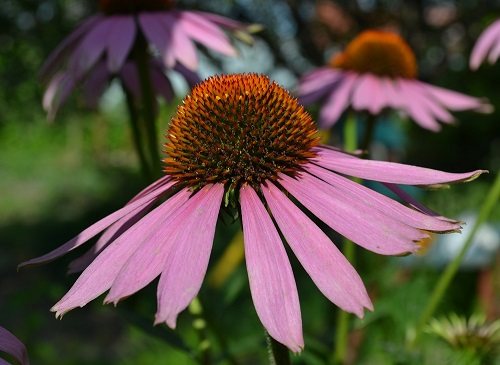

Echinacea purpurea - description
Echinacea purpurea. In this article, you will find guidelines for planting, growing and caring for this plant.
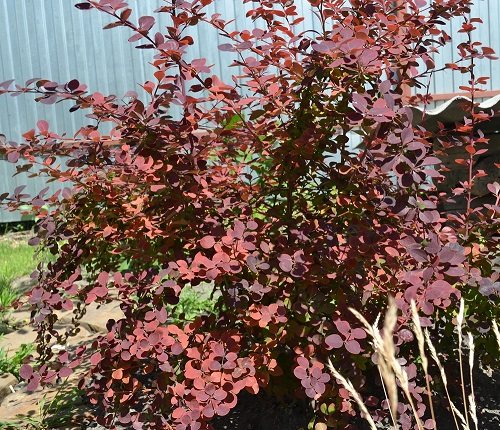

Barberry Ottawa Superba - description
Detailed description of the Ottawa barberry shrub. Specialist recommendations for planting, growing and caring for barberry.
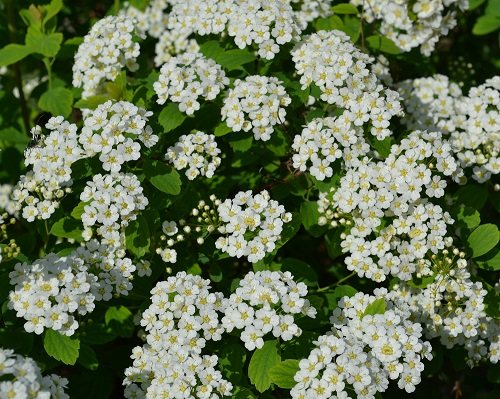

Spirea Wangutta - description
In this article, you will find tips and advice from an expert on planting, growing and caring for the wangutta spirea shrub.
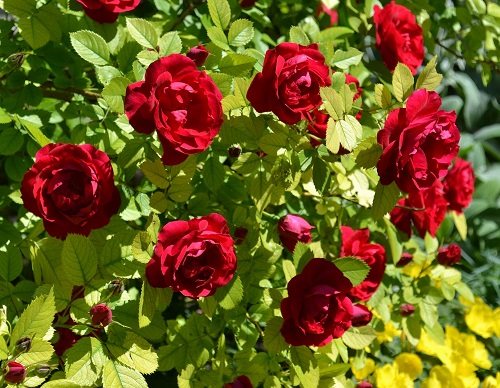

Rosa Flamentants: description and cultivation
Rosa Flamentants: a description of the main features and recommendations for planting, growing, reproducing and caring for a rose.
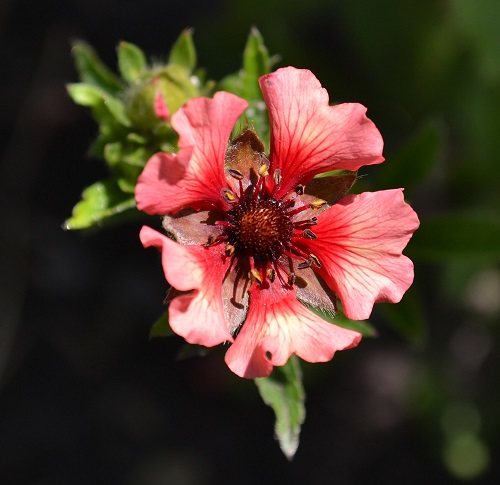

Cinquefoil - growing and care
Description of the popular perennial garden flower - Potentilla. Tips for gardeners on how to plant and care for Potentilla.
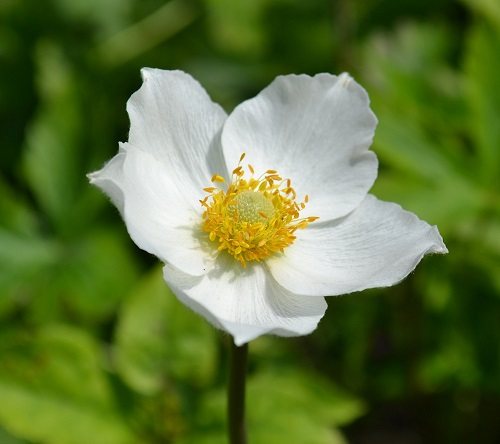

Forest anemone - description
Planting, caring for and growing a perennial plant anemone forest has its own characteristics.
Reproduction of white turf for practical purposes
White dogwood is very popular with gardeners, so it is quite possible to make additional income from it. It can be grown and propagated for sale. You don't have to make a lot of effort, and this will not pull large investments either. All that is needed is to properly collect the cuttings, plant them and provide proper care.
Variegated sod will serve as a wonderful decoration for a garden plot. The plant is distinguished by its beauty, and looks great in any weather.
What is a house with a gorgeous garden? First of all - the face of the owner, an indicator of his taste and beauty. On the site you can place all kinds of plants - ampelous or huge bushes. And today we will talk about such, at first glance, nondescript shrub, like white dogwood. Why nondescript? The white turf shrub in summer is no different from most shrubs - dense branches with green leaves and small white flowers. However, all of its decorative charm and potential is revealed with the onset of autumn. The hedge formed from it will delight the eye not only in spring and summer, but also in late autumn. The correct ones are described in detail in this article. Well, you can also see the white turf in the photo illustrating all the charm of the shrub: This is a genus of the ornamental family "Kizilovs". In Latin, Cornus (this is its real name) is translated as "horn". And it was obtained for a reason - the branches of the plant are very strong, like the horns of animals.
Description of the variety
The variegated dogwood is one of the brightest achievements of breeders; this plant does not grow in its natural environment. The species was obtained on the basis of white deren from the cornel family. Such a plant has green monochromatic leaves, but through the efforts of scientists, several bright colors were added to them, as a result, a border of yellow, pink, golden and white-beige color appeared on the foliage. The shape of the leaves is heart-shaped, the edge is even, the main vein is clearly pronounced.
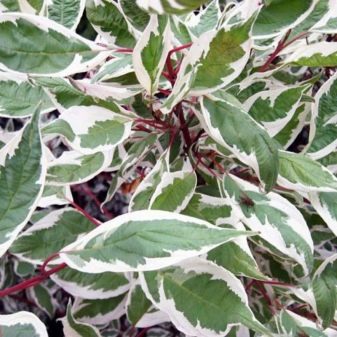

Derain variegated is a shrub or a small tree, grows up to 2.5-3 meters in height, while the crown reaches 4-5 meters in diameter.
The bark has a rather unusual color - coral or saturated brick, which gives a glossy shine in the sun. That is why the plant is so popular with landscape designers. It does not lose its decorative and exotic character even in the winter months, having lost all its foliage. At this time, its red branches look especially beautiful against the background of sparkling white snow.
The culture bears fruit twice a year. The first time it blooms at the end of May - the first half of June, and the berries appear after 1.5 months. The second wave occurs approximately in the last decade of August - early September, respectively, the plant gives the second harvest of ripe berries already in October. They look extremely stylish against the background of yellowing and purple foliage. The flowers of the tree with thyroid inflorescences are 4-5 cm in size, the fruits are blue and bluish, but for all their attractiveness they are completely inedible.
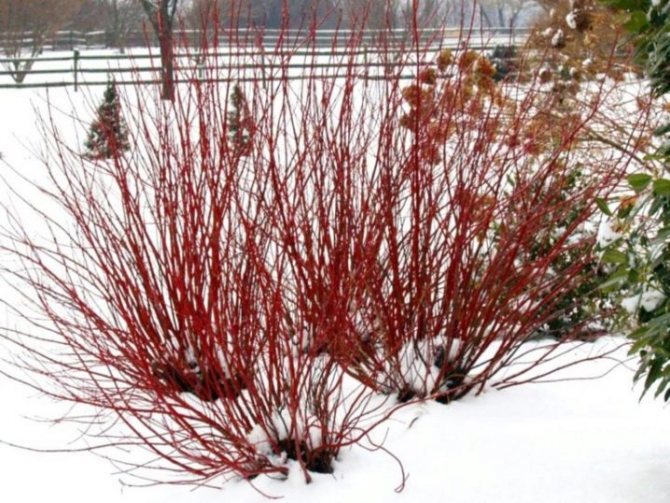

A distinctive feature of deren is the increased growth rateas well as the ability to tolerate any crop, even radial, without any damage. Moreover, the more often such procedures are carried out, the thicker the crown becomes. It is this feature that is used when arranging hedges. It should be noted that pruning is the main part of the care of the turf, since the branches that grow uncontrollably look extremely untidy and unattractive.
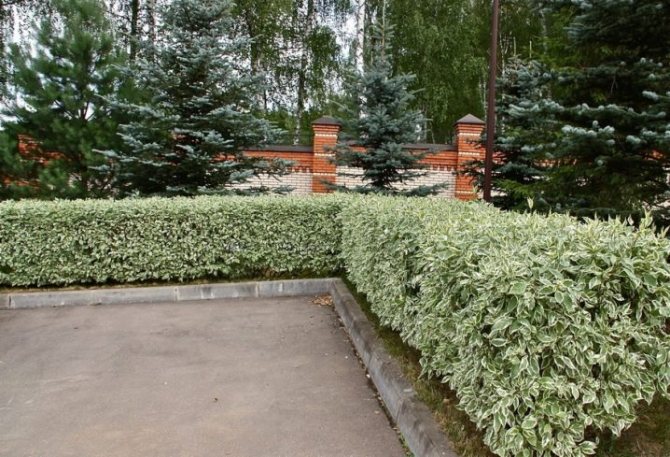

The plant is absolutely undemanding to care, the culture can adapt to almost any habitat, the turf is unpretentious neither to the composition nor to the structure of the soil, it can withstand even the most severe Siberian frosts and grows easily in the southern regions. There are several varieties of deren, so every gardener will always find the one that suits his taste. They all differ in their appearance, but at the same time each one looks invariably impressive.
- Elegantissima. This is one of the most common varieties of deren, which is often planted in single plantings. The shrub reaches a height of 2.5 m, shoots are rich coral, straight, young foliage is green with a slight bluish tint, the border is milky white, the leaves are pointed and slightly concave inward.
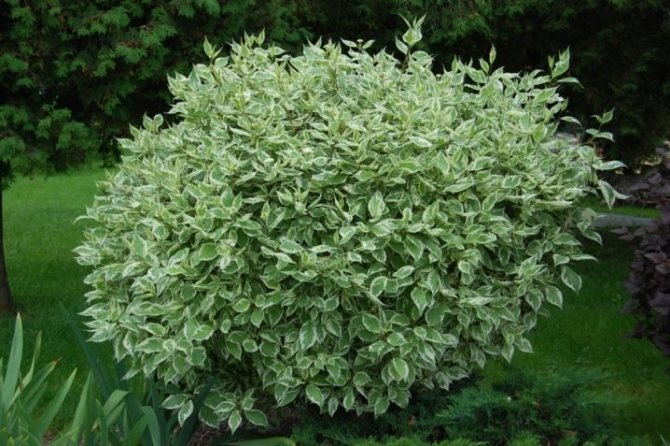

- Sibirica Variegata. This is a low-growing shrub that grows up to 1.5 m. Shoots are bright scarlet, almost bloody. The leaves are elongated, light green with a creamy edging. With the onset of autumn, they change their shade to bright purple with a pronounced lilac tint. The berries are dark blue, covered with a thin layer of "waxy" bloom.
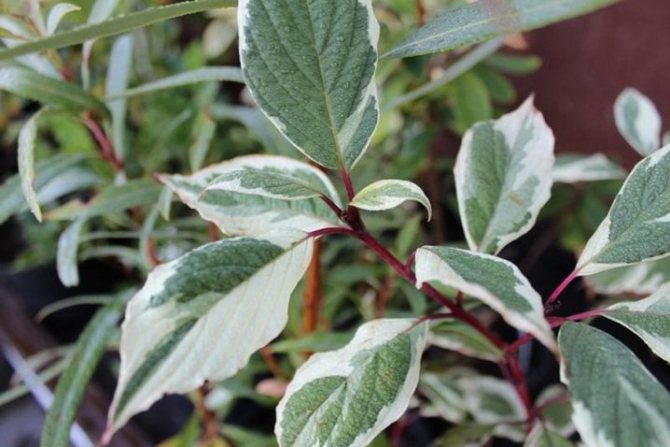

- "Gouchaultii". Squat, but very massive shrub. The height reaches 1.5 m, the shoots are red, dull, very flexible. The leaves have a lemon-yellow border. If such a plant is planted in open sunny areas, then the foliage begins to cast pink. The fruits are lilac.
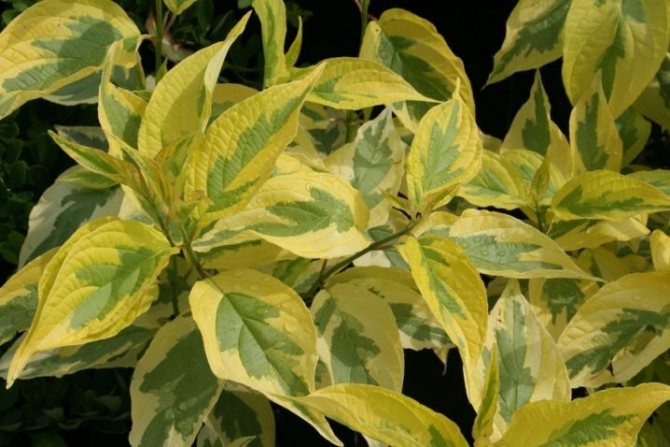

- "Cream Cracker". Quite an exquisite, upward-looking shrub, from which standard trees are usually formed. The edging on the leaves is light beige, in autumn it changes its color to lilac.
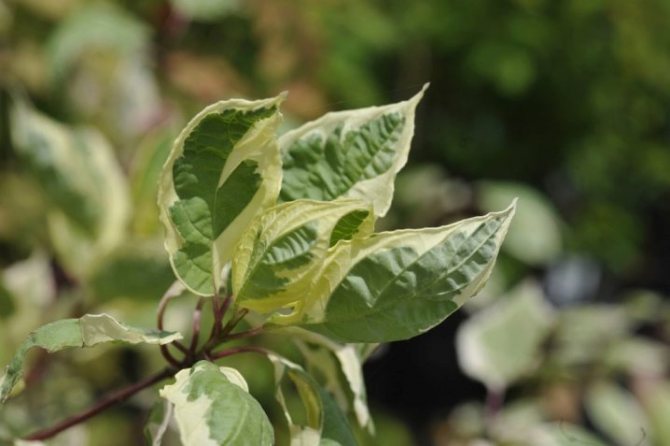

- "Spaethii". This variety was bred about a hundred years ago. The leaves have a golden yellow edging that sometimes covers most of the plate. Young leaves are orange, and in autumn they change color to purple, almost purple. The plant grows rapidly - the annual growth is 20-25 cm, it is resistant to frost and heat.
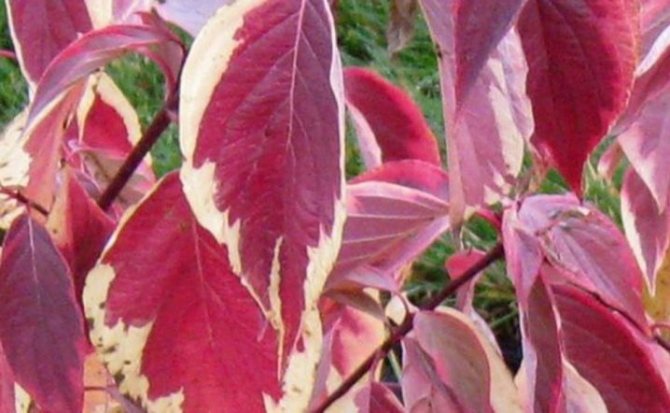

- "Argenteomarginata". A fairly tall tree, growing up to 3 m, the leaves are elongated (up to 10 cm), silvery yellow, the border is milky. In winter, the foliage changes color to lemon or brick. The berries are dark yellow with a slight bluish tint.
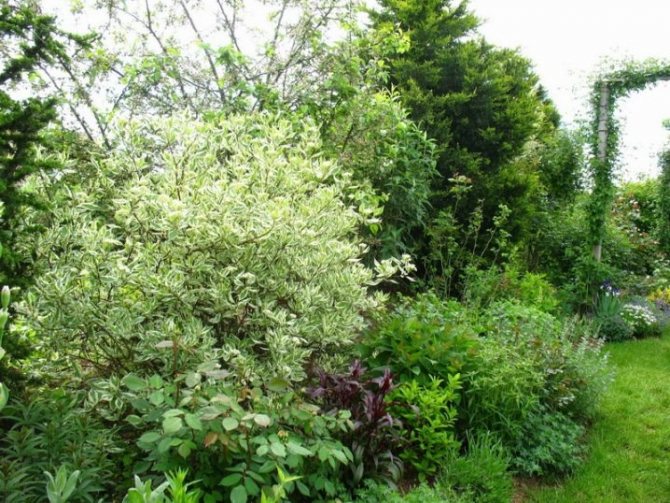

- Ivory Halo. A low-growing plant, does not grow more than 1.5 m, the crown is spherical, and takes the desired shape even in the absence of pruning. The foliage is light green, the edging has a shade of eggshell. Scarlet bark, as it develops, changes color to brick.
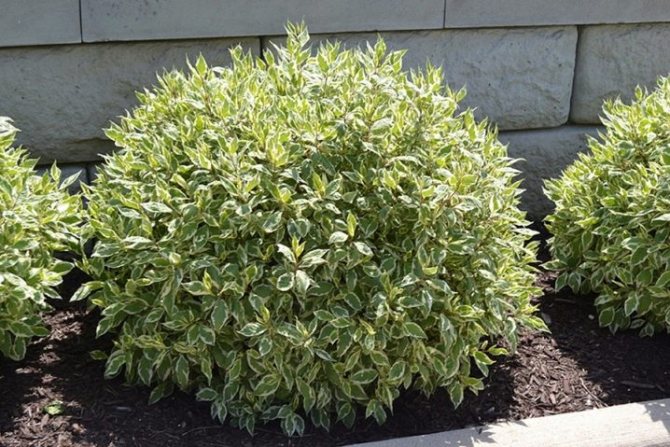

- "Kernii". The shrub grows up to 2-3 m, has an unusual burgundy bark, leaves of lime-lemon color, a border of bright yellow and beige tint.
- Westonbirt. The shrub reaches a length of 1.5 m, is distinguished by pink leaves and coral shoots.
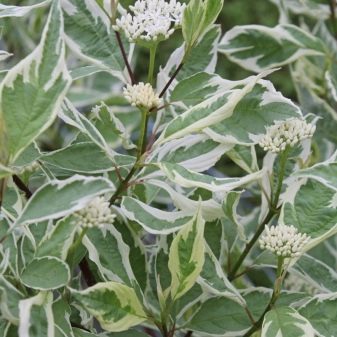

- A very popular variety - "Compress" - it has crimson shoots and red leaves, so it has a very decorative and exotic look.
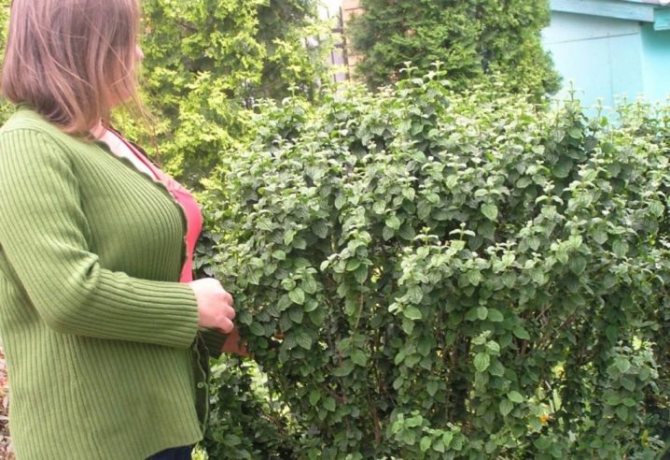

What is the secret of the bush?
In culture, white dogwood is described as a hedge that changes its dress several times a year. After all, as soon as the heat subsides, the period of rains will begin, the cooling of the dogwood will heal in a new way. The first impression of him is an ordinary, unremarkable bush. All the greenery that surrounded the branches becomes completely different - they transform into burning orange leaves. They can also be purple, red, and even purple. It all depends on the variety that was planted. And in winter you can observe the wonderful coral-colored bark of the branches. The decorative value of this shrub is very high due to these qualities of reincarnation in different periods of the year. Among gardeners, white dogwood or cornus alba remains the leader among gardeners. Very tall bushes, sometimes reaching three meters, cannot be unnoticed. It blooms twice a year - after 2-3 years of growth, the first flowering period will begin in early summer and may be repeated in September. In addition to flowers, fruits will appear. So, this plant is also used as a fruitful one. Some species are known for their delicious, sweet and sour red fruits.
Chubushnik pruning
To get a beautiful chubushnik bush, you first need to form it correctly. For this, the seedling is cut very low, and young shoots "shoot" from its base. The next year, they leave several of the strongest and most harmoniously located. All the rest are cut out.
Since the mock-orange blooms on the lateral (shortened) shoots of last year's growths, the faded branches after flowering are removed to the strong young shoots located below.
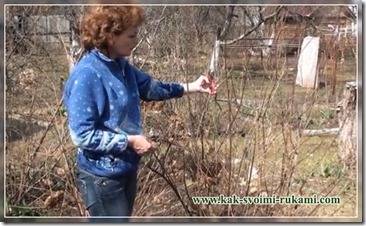

In the fall, side branches form on them, which will bloom the next year. It is also necessary to cut out old, weak and thickening branches. Make sure that the bush does not thicken and retains the shape given to it, for example, a ball. If shoots appear that are knocked out of it, they need to be cut off at an internode, which is not at the level of the ball's contour, but one below it. The shortened lateral shoots that appear will make the bush more luxuriant and bloom next year.
The old bush is rejuvenated by pruning "on a stump", it quickly grows the crown.
After rejuvenation, the chubushnik is abundantly watered and fed.
Correct planting and reproduction of white turf
The best time to plant white turf is early spring. In this case, the plant will have enough time to root well. This will allow the roots to absorb minerals well from the ground, which will further promote healthy growth. And by winter it will fully ripen and safely survive the cold. The correct planting of the white turf begins with the selection of the site and the planting line. In general, these bushes are unpretentious to the composition of the soil. But if the gardener starts everything from scratch, then there will be a need for the following:
- Before planting, you need to prepare the soil - in a hole that was prepared in advance, you need to apply organic fertilizers - humus, for example;
- If the area where the bush will grow is swampy, then drainage is needed;
- Also, drainage is necessary in soils with highly suitable waters.
When buying a ready-made bush, you must choose a young seedling, no older than 3-4 years. And pay close attention to the roots - if they are a little dried up, then they must be placed in water for a while so that the plant is saturated with moisture. Let's talk about the reproduction of white turf, which can occur in two ways - planting seeds and cuttings. The seeds are sold in flower shops.Gardeners who have planted their crops collect seeds that are stored for no more than 5 years. Prepared seeds are planted in the ground in late autumn or early spring. The holes should be no deeper than 5 cm. In order for the dogwood to grow, you will have to wait 5 to 8 years. As for cuttings, an important fact must be emphasized - the plant will grow so much faster. The strongest and healthiest bushes are selected, from which green cuttings are cut. Cuttings are planted in June so that the roots can germinate well until autumn. For the winter period, they are insulated or brought into the room.
Plant propagation methods
Cuttings are the preferred breeding method
Variegated dogwood can be propagated by seeds, layering and cuttings, each method has its own characteristics, advantages and disadvantages.
A plant that has reached the age of three years can bloom and give seeds.
Interestingly, almost 100% of seeds germinate, stratified seeds are planted in the soil in spring, and collected in the garden in autumn.
Decorative forms of variegated turf reproduce better vegetatively, this is the most reliable way to preserve all the qualities of the mother plant.
To root a green stalk, you need to carefully protect it from winter frosts, since there is a very high probability that it will die.
Experienced gardeners recommend propagating the grass with lignified cuttings, since under the bark along the entire length of the plant there are rudiments of roots that can awaken at any time and prevent the plant from dying.
Due to the prevalence of the shrub and the high level of survival, it can be purchased for free from friends or neighbors, one branch or shoot will be enough.
Guidelines for caring for a white turf hedge throughout the year
The most important thing in caring for white dogwood is pruning. It should be done regularly for a three-year-old plant. Without it, the lower part of the bush begins to bare, which will lead to its death. Usually, pruning is done twice a year, in autumn and spring. For pruning, the oldest shoots are selected, which in the future will be the cause of exposure. The rules for caring for a hedge throughout the year include timely feeding and loosening the topsoil. White turf hedges grow rapidly and require fertile soil. Trimming of hedge turf is carried out in the summer, in July and in August, when the shoots bloom profusely. And those bushes that were planted for the sake of decorative bark in winter are carried out once every 2-3 years in early spring. Branches are cut, on which leaves have not yet begun to grow at a distance of 20 cm from the base. This will lead to abundant growth of new branches. Unpretentiousness is a good factor for a novice gardener. Watering is not necessary often. In dry weather, the bushes are watered no more than 3 times a month. Each dogwood takes about 15-20 liters of water per watering. Top dressing for turf is also optional. Only during the period of development after planting several times can it be fertilized with humus.
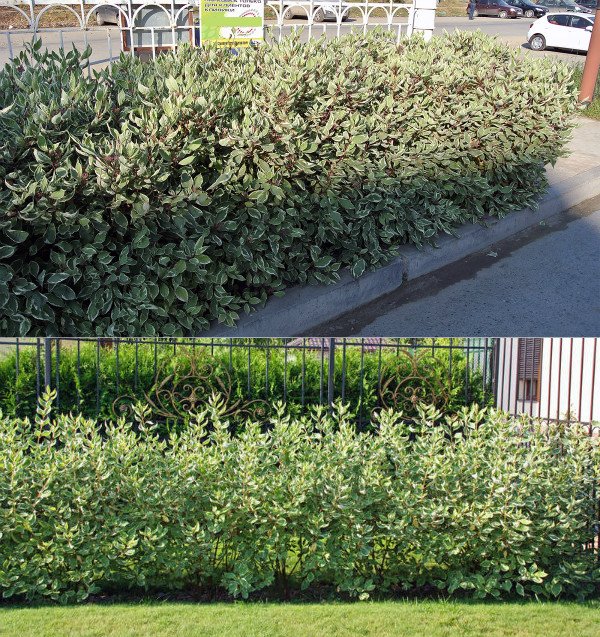

Pruning variegated sod
The main purpose of turf trimming is to give the shrub a beautiful and aesthetic shape. If this procedure is not followed, then the appearance of the plant will become sloppy over time, and the lower part will get rid of the leaves.
Pruning of mature and old bushes is carried out in early spring, it should be low, as the grass grows incredibly quickly.
Chimeras are plants composed of tissues with different genotypes
When breeding, it must be borne in mind that variegated dogwood belongs to chimeras, that is, to plants whose structure consists of cells and tissues that differ at the genetic level, therefore, sometimes the gardener can detect the appearance of solid green leaves.
In this case, do not hesitate, since the green part of the shrub is genetically stronger, if it is not removed in a timely manner, the plant will turn completely green.
Interested in planting and caring for a thuja? We'll tell you.
We plant Japanese euonymus - read here
The most popular types of deren for hedges (with photo)
Breeders and nature have developed many species that are designed for different purposes. The most popular types of white turf for hedges among gardeners will be considered further. They can also be seen in the photo. Some are used for planting hedges, others for winter beauty. And now we will talk about the most popular varieties and their characteristics: In the photo, white dogwood looks very interesting, especially in the form of a hedge. How a single plant looks ridiculous. It is useful not only as an ornamental plant, but also as a fruitful one.
Plant growing conditions
Deren leaves are simple, whole-edged, on long petioles. Flowers are small, white with different shades in different species and varieties, collected in corymbose inflorescences. The fruit is a drupe. Depending on the type and variety, the berries can be white, bluish, black or another color. Some fruits are edible and healthy. The bark is used as a medicinal raw material. The wood of deren is very dense and durable; it is used for the manufacture of smoking pipes, canes, handles for various tools.
Since the natural distribution of deren is in temperate latitudes, this plant is perfect for decorating gardens and household plots in central Russia. All artificially obtained varieties of deren, or, as it is also called, svidins, are distinguished by winter hardiness, good drought resistance and undemanding soil composition.
Doren: a general description of the genus
Dogwood is a genus of deciduous or evergreen shrubs of the northern hemisphere, belongs to the Cornaceae family. Some classifiers combine Svidina with the genus Cornel, therefore dogwood and dogwood share a common Latin name - Cornus.
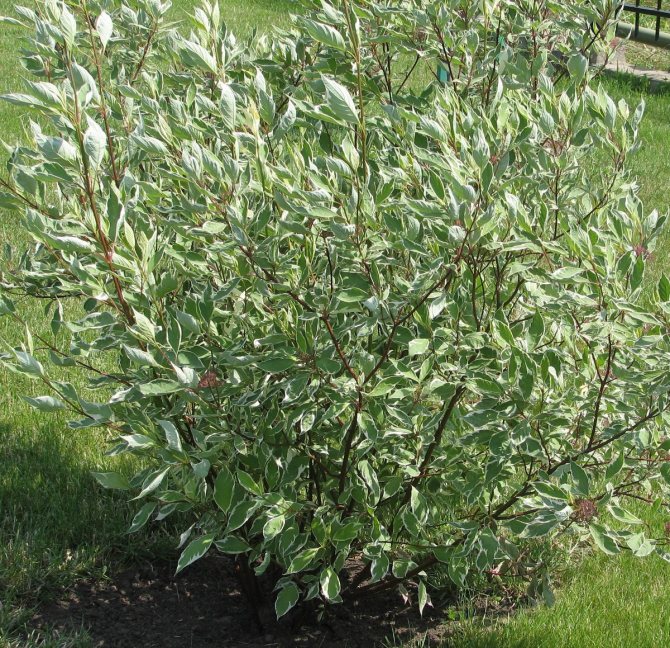

Dogwood variegated
Representatives of the dogwood genus are distinguished by year-round decorativeness. In summer, they stand out with white or golden inflorescences, and some varieties have extraordinary foliage. In autumn we can admire their snow-white, blue or black berries against the background of crimson or scarlet foliage, while winter allows us to see exotic bush branches - red, orange, yellow, bright green ...
I remember how, as a child, I brought from the forest a purple branch of svidina with deathly blue berries. Parents immediately threw it out - in their opinion, the berries of the bush looked suspicious and dangerous. However, they were afraid in vain. The turf berries are not poisonous, despite their strange appearance.
Dogwood can often be found in the forests of Russia. It is distinguished by its absolute undemandingness to soil, climatic and environmental conditions. Some species are hardy enough to grow well even in Siberia in the north of the Tomsk region and other cold regions. On the Tom embankment, it perfectly withstands icy winds, light snow on the slopes and quickly recovers from damage from the spring ice drift.
Turf planting, care and disease control
The turf planting is carried out immediately after the retreat of spring frosts according to the standard method. Don't bury the root collar, fertilize with fresh manure, and don't forget to spill well after planting - these are the basic rules I can remind you of for planting turf.
Dogwood is shade-tolerant, tolerates both poor and waterlogged soils, but remember that he will not give up a sunny place, fertile garden land and drainage.
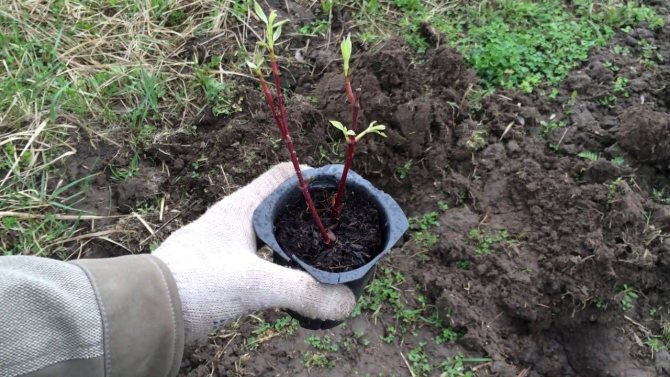

Derain planting
Caring for dogwood is simple and is needed mainly to improve the decorative qualities of the plant. Watering during dry periods, mulching with peat crumb, weeding, shallow loosening of the soil, top dressing and pruning will help your shrub to be beautiful.
It is better to feed svidina in two stages: in spring - complex mineral fertilizers, and in the middle of summer - organic fertilizers.But without timely feeding the dogwood will live quietly and will not notice anything, but without pruning it will live like a ram without a haircut.
Sanitary pruning of turf is carried out in the spring after the leaves bloom, when it becomes clear which branches are alive and which ones are dead. If you want to enjoy the abundant flowering and foliage of the shrub, prune to the desired length in the fall (but no more than two-thirds of the shoots). If you want to admire the scarlet branches over the snow canopy, postpone pruning until early spring. Since dogwood grows very quickly, many gardeners will prune a third or a quarter of the shoots 2-3 times per season to keep the bush neat.
When the bush on your site begins to age, you can safely cut off all the shoots in early spring so that they do not rise more than 15 cm above the ground. With the beginning of the growing season, young bright shoots will take the place of decrepit branches.
Most species and varieties of turf do not require shelter for the winter. Sometimes they are just covered with snow just in case. But thermophilic varieties, like Japanese turf, do not hurt to cover, so always check with the sellers of planting material if the variety you have chosen requires shelter in your climatic zone.
Now about the diseases of Svidina. The "four horsemen of the apocalypse" when growing turf are gray rot, powdery mildew, aphids and scale insects. The first two riders are fungal diseases, so when the first symptoms appear, you should reduce watering (fungi actively multiply and spread in an environment with high humidity) and treat the bush with Bordeaux liquid or preparations "Hom", "Vectra". Aphids and scale insects are malicious pests, the fight against them can be carried out both with the help of treatment with chemicals like "Karbofos", and with the help of decoction of the tops of potatoes, yarrow, tobacco.
Spirea pruning
Summer-flowering spireas are pruned in the fall in order to obtain lush, intensely flowering plants for the next season. Just as for hydrangeas, the height of the cut depends on the age of the shrub. For bushes over ten years old, it is recommended to prune at the damage of the soil to a stump for a complete renewal of the skeletal part of the crown. Such a zero-cut haircut will not affect flowering in any way. These spireas bloom on the shoots of the current year, so strong young branches grow from dormant buds in spring, blooming at the right time.
If the bushes are young, they can be slightly thinned out, the oldest branches removed, the rest can be shortened to a height of thirty centimeters. With this pruning, shoots will develop from lateral buds in spring. After pruning, it is very useful to mulch with peat or humus, this will feed the bush and cover its root system from unwanted hypothermia.
Summarizing the above, it should be noted that pruning ornamental shrubs in autumn is not too laborious, but very important for plants, which will surely reward for love and care with lush flowering in the coming season.
How to grow variegated dogwood in a summer cottage
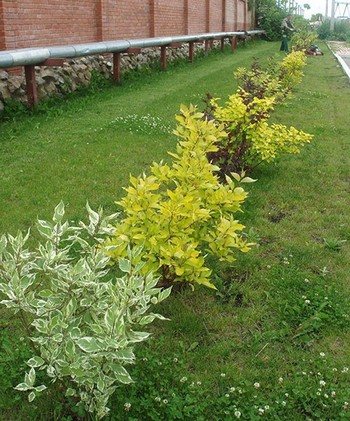

In the process of creating hedges, a plant such as variegated sod is most often used. It looks like a large shrub, so it can often be seen in the compositions of landscape projects. Also, the plant is planted in city parks and squares. Variegated turf grows rather quickly, its bark acquires an original color, and its leaves have a bright border. Taking care of the plant is quite simple, so you can safely use it as a decoration for the site.
Varieties of variegated turf
The purple branches are rich in color and green leaves with white edging. In the fall, they sometimes turn red-pink.
The two-meter bush has pale concave leaves bordered by a wide white stripe.
Large green leaves are colored yellow at the edges. In autumn, the edging acquires a red color.
Erect dogwood of this variety has leaves with a cream edging.
Twisted leaves, dark or brownish green, are a feature of this species.
Tall shrub with yellow edging of green leaves. Under the influence of the spring sun, the border turns pink.
If the appearance of the turf deteriorates
The plant can infect:
- Anthracnose - this is his most frequent disease. At the same time, brown spots appear on the foliage, which eventually acquire a brown tint, after which the leaves dry out. With severe damage, the cortex may be covered with necrosis. Treatment is possible until the branches begin to die off.
- With a very dense planting, the plant can get sick with powdery mildew., more often this disease manifests itself in the second half of summer. This can be determined by the gray bloom on the leaves.
- During a period of high humidity, the sod can be affected by fungus., which promotes foliage falling. To prevent fungal diseases, it is enough to properly care for the shrub. Cut diseased parts of the plant must be burned, and the bush must be treated with a fungicide.
Turf leaves may begin to darken, the edges curl and fall off, and they may turn pink on the inside. All of these conditions can occur during stress, which is caused by prolonged drought or extreme heat. It can also be a sign of too much fertilization.
- Leaf burn looks like yellowed and dried edges. It occurs with very dry air and insufficient watering. Most often, young plants in which the root system has not yet adapted to this ailment are exposed.
Features of grafting deren
There are many varieties of deer in nature. However, they are vegetatively all similar, which means that they have common features of reproduction. Many gardeners consider cuttings to be the easiest and most affordable way. Derain is a strong and unassuming plant, therefore it grows actively when creating minimal favorable conditions.
For decorative purposes, the shrub is usually pruned in the spring or fall. The resulting branches can be safely used as planting material. A specially cut lateral shoot on a thick branch is also suitable for these purposes. Not every branch can be considered a full-fledged cutting, but only one that meets certain requirements:
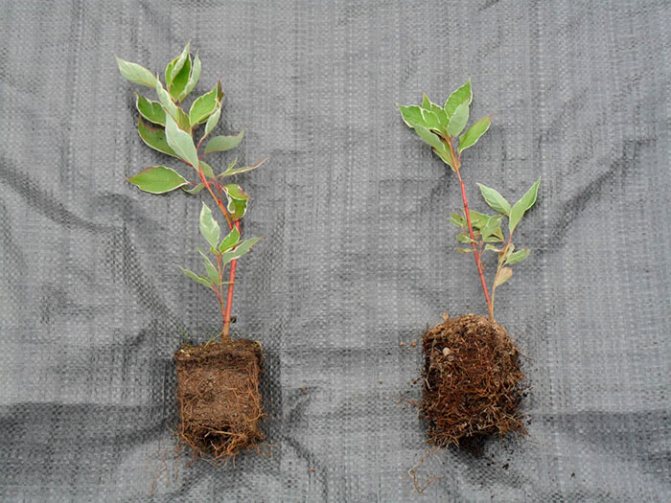

Deren saplings
- The shoot has 7-9 intact and developed buds.
- It does not break when bent. Gardeners test the twigs by pinching them between three fingers. The specimen should return to its original shape after bending.
Plant varieties
There are four types of turf:
- dogwood, which can grow as shrubs or small trees. Dogwood fruits can be eaten;
- svidina bears fruit that is poisonous, so they should not be consumed. The shrub blooms with white inflorescences. Svidina is used to create landscaping;
- fruits of bentamidia, like dogwood, can be used in cooking. Due to its attractive appearance, the shrub is used to decorate garden plots, as well as city parks;
- the hameperiklimenum shrub has a creeping form. Lawns are decorated with beautiful thickets of plants.
When buying a dogwood, it is important to find out what variety it belongs to, in order to properly care for it in the future, as well as to choose the right way of reproduction.
Pruning types
The next step for a chic green hedge is pruning variegated turf.
In general, there are three types of pruning: sanitary, decorative (it is also formative) and anti-aging.
A sanitary one is needed if defective branches are found - broken or sick. It is advisable to burn shoots affected by infection or parasites.
Forming pruning aims to give the shapeless crown a neat, attractive appearance. Thanks to her, you can direct the growth of shoots in the direction you need.
Finally, anti-aging is intended for aged trees and bushes.Thanks to her, old shoots are replaced by new, more attractive ones, with the maximum number of flowers and fruits.
Deer breeding
Reproduction of deren is possible by sowing seeds or by vegetative methods, namely:
- cuttings;
- dividing the bush;
- layering.
Important! Vegetative propagation methods have 2 important advantages over the seed method: the speed of obtaining a full-fledged plant and the preservation of all varietal qualities of the parent.
Reproduction of deren by cuttings
The propagation of deren by cuttings can be carried out both in autumn and in spring, however, spring breeding in this way is more effective.
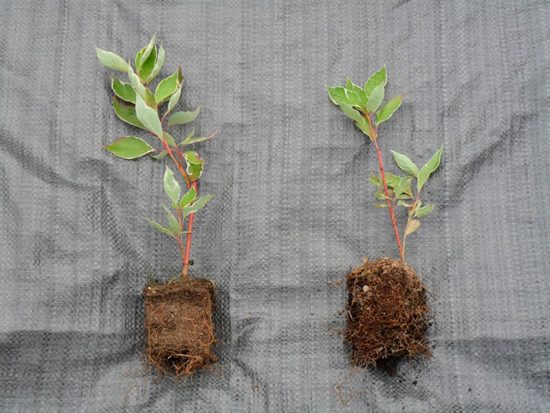

The propagation algorithm of a plant by cuttings looks like this:
- In the spring, parts of the young branches are cut off from the selected bush.
- They are buried in the ground in spacious boxes. The composition of the soil mixture should include river sand and humus.
- Landing of the segments is made at an angle of 45 °.
- Containers with cuttings are placed in a greenhouse with a temperature of + 25-35 ° C and the soil is moistened from time to time. In this case, it is necessary to shade the walls of the greenhouse - direct sunlight negatively affects the development of cuttings.
- In the fall, planting material can be planted in a permanent place.
Important! In the first year of life, the plant does not tolerate severe winters, therefore it is recommended to cover young seedlings with spruce branches.
By dividing the bush
Shrub reproduction occurs according to the following scheme:
- Choose a strong, healthy bush that grows well to the sides.
- Dig it out, removing excess soil from the roots.
- With the tip of a shovel or a knife, the rhizome of the bush is divided into 3-4 parts.
- The reproduction procedure ends by seating the divisions in pre-prepared holes filled with fertilizers.
Layers
Propagation by layering is as popular as propagation by cuttings of the culture. This is explained by the simplicity of the process:
- In the spring, an annual shoot is chosen on the shrub at the bottom of the plant and gently tilt it towards the ground.
- The end of the branch is slightly dripped into the moistened soil.
- In order for the shoot lowered to the ground to remain in this position, it is fixed with a bracket or a stone.
- The separated branch is watered on a par with the mother bush.
- With the onset of autumn, it is finally separated from the plant and transplanted.
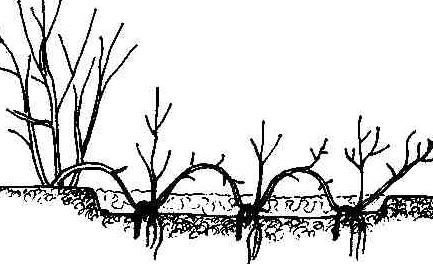

Seeds
The plant blooms in May or early June, after which small white bolls form on the shoots. In the fall, they are harvested and seeds are extracted from them. At the same time, sowing is carried out immediately to a permanent place. After stratification of the planting material, it is better to postpone planting until the spring.
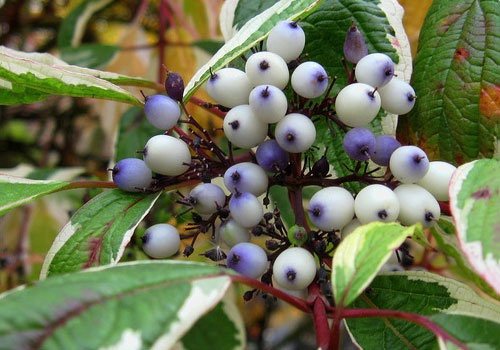

The seeds are buried in the ground by about 4-5 cm.
Seed propagation is the most laborious. The first shoots after sowing the seeds hatch after a few years, and the maximum growth is achieved in the best case in 10-12 years.
Important! Seed propagation can lead to the loss of some key characteristics of the variety.
Diseases and pests
There are practically no natural enemies. It can be affected by aphids. In this case, it is necessary to wash off the insects with a hose, usually this treatment is sufficient. If it does not help, then you should use special solutions (you can treat it with a solution of laundry soap or apply chemicals). Of the diseases, only fungal diseases are dangerous. They attack the root system when excessive moisture is present. To begin with, watering is reduced. The plant will perfectly tolerate artificial drought, and the fungus that causes root rot will stop multiplying. If it does not help, then granules of Glyocladin or Trichodermin are added to the ground, and the branches are sprayed with a fungicide.
For prevention: in order to avoid the development of fungal diseases, it is enough to periodically water it not with ordinary water, but with a weak pale pink solution of potassium permanganate.
All varieties and hybrids are extremely unpretentious. They look spectacular at any time of the year, are frost-resistant, easily tolerate drought.Shrubs planted in your garden will help strengthen the soil with a powerful root system.
A little about other species
Before talking about the reproduction of variegated turf by cuttings, it is worth briefly talking about other representatives of this family - there are a lot of them and they differ quite a lot. In general, their number reaches fifty, but only a few plant species are of greatest interest for landscape design.
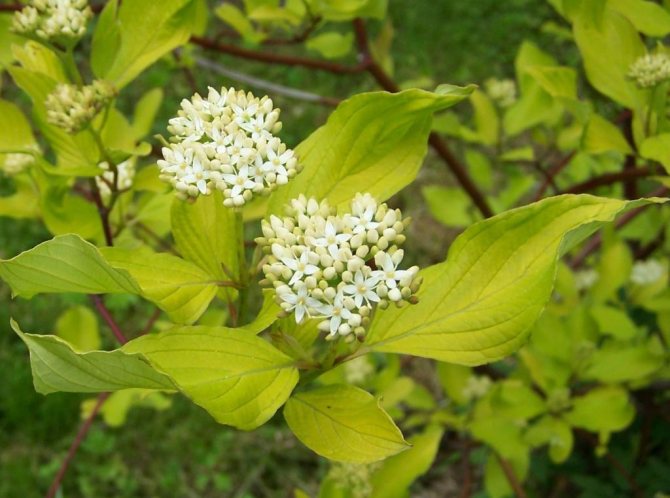

One of the most famous is the white dogwood, on the basis of which variegated was derived. In the wild, it grows in North Asia. It is a high (up to three meters) shrub, and reaches this height quite quickly. The leaves are dark green, sometimes with a bluish tinge. In the fall, they acquire a rich yellow color. The fruits and flowers are white. Young trees have bright red grass, while old trees have gray. It also blooms twice - in early summer and autumn. It is very unpretentious to the soil, grows well in the shade and is not afraid of the wind.
The blood red turf is also known as svidina. Grows in Central Europe. Differs in considerable height - with proper care and proper formation, up to eight meters. The leaves are dark green, elliptical in shape. By winter, the color changes significantly - from light orange and yellow to deep red. It is not whimsical to the soil, but it grows rather poorly on acidic and poor sandy ones, it needs to increase the pH and additional feeding.
Derain male (aka common dogwood) is the only plant in its kind with edible fruits. In the first years of life, it grows rather slowly, but then it makes a leap and may well grow up to eight meters. A young tree grows rapidly upward, and already in adulthood it becomes more rounded. The leaves are beautiful - green, with a shiny surface. It blooms in small yellow flowers for about three weeks. The aroma is subtle, pleasant, sweet. The fruits are edible, sour. Therefore, the dogwood will serve not only as a hedge, but also as a fruit crop.
How dogwood is propagated
It is possible to plant the grass with seeds - this is a rather lengthy process, so that the bush grows to standard sizes, you will need to wait up to 7-8 years. Therefore, this method is rarely used, although the germination of seeds is 100%.
It is better to propagate the shrub vegetatively - it is quick, simple and effective.
Dividing the bush in spring
- An overgrown bush is dug up;
- The root part is freed from the earth;
- A bush is cut with a sharp, clean knife;
- They are planted in prepared pits, sprinkled with humus, watered.
Cuttings
- In the spring, when cutting branches, a stalk with 7-9 good buds is harvested;
- Plant the twigs in a fertile substrate in a greenhouse (either in the ground or under a plastic jar);
- In summer, seedlings are watered, ventilated and fed with fertilizers;
- During this time, roots will appear, in the fall you can plant new trees in a permanent place.
Layers
The spreading crown of the variegated sod makes it easy to get layering from the mother bush.
- A flowing, flexible shoot is taken and bends over;
- You can pin it to the ground with a metal bracket or steel wire;
- Sprinkle with humus, water;
- Spring manipulation will allow the branch to take root by autumn;
- Cut off this stem before wintering and transplant it to a prepared place next spring.
How to trim correctly
As mentioned above, when working with lawn, you need to use good tools - sharp, well-assembled. Then the cut sites heal quickly, the infection does not get there and the loss of juice is reduced to a minimum.


The best time to work is evening or morning on a cloudy day. In the heat, pruning is impossible - the loss of moisture will increase. But even before the rain, it is also not the most suitable time - the jets can wash away dust from the leaves, and with them the infection that gets into fresh wounds.
Giving specific advice on pruning is especially difficult.After all, much here depends on the aesthetic preferences of the gardener. You just need to give the bushes the shape you want and make sure that the plant does not "blur".
With rejuvenating pruning, everything is easier - you need to remove old branches with tarnished bark to restore attractiveness and youth. Remove them at the root.
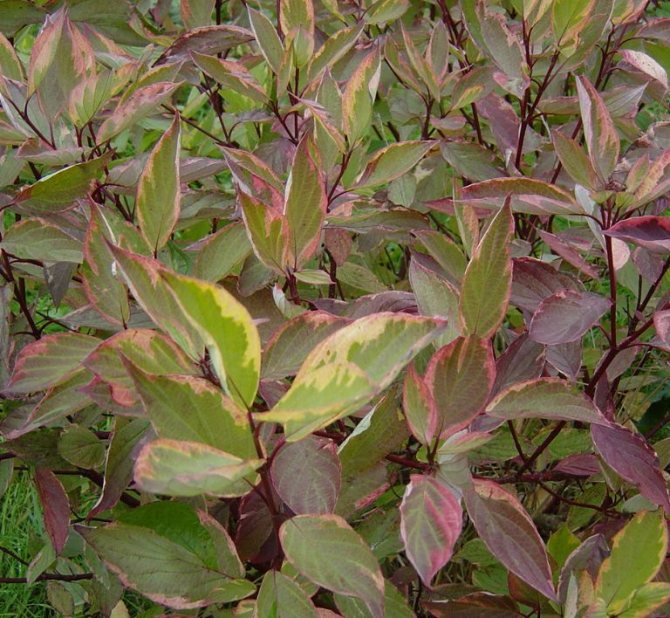

Sanitary pruning won't be a hassle either. Cut damaged branches whole or 5-10 centimeters below the problem area.
Planting young seedlings of variegated sod on the site
Variegated Derain will grow everywhere, but poor conditions will affect its decorative qualities. The soil requires more nutritional value than traditional varieties, otherwise the leaves will have a dirty pattern instead of a variegated color. This also applies to the lack of water and lighting.
When is the best time to plant
The variegated dogwood should have time to get stronger before frost, so planting should be carried out in the spring.
Although the turf is variegated and stable, planting in spring will give it time to grow stronger and stock up on strength for the winter.
Where is better to plant
The best option for planting variegated sod is partial shade. It is not particularly picky about soils, but acidified, with the addition of lime, are best suited.
Important!
It is worth avoiding close proximity to tall and coniferous trees, it is also recommended to place shrubs away from other plants.
How to plant correctly
In order for the plant to grow as beautiful as possible, it is advisable to properly prepare the planting site by adding compost or humus to it. If the soil is swampy or the groundwater is close to the surface, additional drainage should be done.
Did you know?
The hole should be dug out more so that the rapidly growing root system grows freely.
Planting must be done strictly along the root collar, otherwise, with a deep planting, the plant will die, and with too superficial, many weak offspring are formed. If variegated sod is planted in the form of a separate tree, then at first the seedling must be tied to a peg because of the thin trunk. After planting, the plant must be watered abundantly, then the crust is loosened, and the soil surface is mulched.
Distinctive features of variegated sod
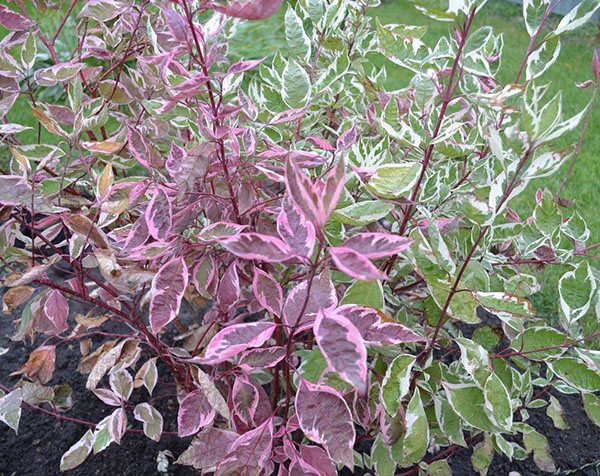

This plant was artificially bred. The shrub has spreading branches and a large crown in diameter. Adult shoots turn red.
Do not be afraid to replant the turf, because it adapts very quickly to any growing conditions.
The leaves of the shrub are characterized by a green tint, which can have a light or dark tint. The upper part of the plates is covered with a pattern of yellow, gold and white tones.
The flowering of variegated sod is long and colorful. During the year, it can be observed twice - at the beginning of summer and in September.
Care rules
The shrub requires attention. So that it grows quickly and pleases with its beauty, it is necessary to add water on time, loosen the soil and remove weeds
... If you take proper care of the plant, it will not be overtaken by diseases and harmful insects. Young seedlings are watered once a week, adults - as needed. If the weather is dry, water should be added more often. One adult plant requires 20 liters.
After watering, you need to loosen, removing weeds. If the plant is planted in fertile soil, the gardener does not need to make additional fertilizing. However, to improve the decorative qualities, mineral compositions should be used. Requires 100 grams per 1 bush. In the middle of summer, it is recommended to fertilize with humus. 5 kg are spent on one bush.
Plant pruning
Young crops are not pruned, shearing is indicated for plants that have reached the age of 3 years. It is recommended to thin out the shoots. Only strong branches are left on the plant... The hedge is adjusted in the middle of summer
, after the shoots grow back. Plants with bright bark are pruned every 3 years.The haircut should be done in the spring before bud break.
Planting and caring for honeysuckle: how to plant bushes correctly
The tree should be shortened by 20 cm. Thanks to the adjustment, the plant forms a large number of shoots and looks very beautiful. You can form bushes in the form of a cube, hemisphere. There is another option - to maintain a natural shape. If there is no desire to carry out formative pruning, sanitary cleaning should be performed, that is, trim unnecessary branches.
Diseases and pests
An adult plant is resistant to diseases and pests. Young shrubs can overtake powdery mildew. The main symptom of the disease is white bloom. If powdery mildew is found, the affected parts should be removed and treated with Bordeaux liquid diluted with water. In the fight against the disease, Fundazol is also effective.
Variegated derain, planting and maintenance of which does not require much time, can decorate a site located in a temperate and southern climate with its decorative appearance. This shrub belongs to the cornel family and is found in the wild in the European part of the Russian Federation and Siberia. The adult bush has a height of about 2.5 m, which allows it to be used as a fence of the site. Its shoots have a beautiful light bluish bloom. Wide oval leaves, resembling an egg, have a different color, which gives the bush a decorative look. The deren has large white flowers that cover the entire shrub, and these advantages of an ornamental shrub attract the close attention of gardeners.
Late autumn is a time of hard work in the garden. It's time for a series of activities that will allow the shrubs to show themselves in all their glory next season. These include autumn feeding, pruning, and shelter. Pruning ornamental shrubs in autumn is a necessary measure for their successful formation and wintering. Autumn pruning is carried out after the end of sap flow, when the leaf completely disappears on deciduous shrubs, but before the onset of stable frosts. This time interval is dictated by the basic rule - “do no harm”. If you start earlier, when the bushes have not yet plunged into a dormant period, then the juice will come out for some time on the cut, thereby weakening the plant. Frost pruning will prevent the slices from healing and will leave a "gate" for infection.
The set of tools required for trimming is quite small. A hacksaw for cutting old thick trunks, garden shears for cutting off unripe shoots and a good assistant to the gardener in all matters - a pruner with long blades that allow you to grab branches up to two centimeters in diameter. All this simple equipment is in everyone who spends at least a little time looking after their garden.
Landing subtleties
It will be correct to plant grass in the spring, since in this case the plant will have the opportunity to grow up over the summer, get stronger, and already prepared and full of strength to go to the first winter. In order for the dogwood to grow healthy and attractive and delight its owners for many years, it is necessary to choose a planting site, prepare a plot of land and purchase suitable seedlings. It is best to give preference to sunny areas. The plant can develop in the shade, but in this case, the color of the leaves loses its brightness and decorative effect. Also, do not plant a bush in places with a high level of groundwater - excess moisture leads to decay of the root system, which, in turn, leads to the death of the plant.
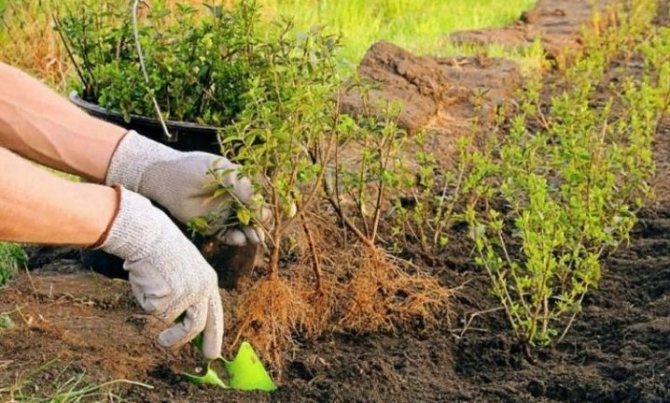

The seat should be well prepared. First you need to remove all the weeds growing there, dig up the ground and apply fertilizer. If the place is swampy, then you should arrange a drainage system in advance. Derain grows well in sandy loam soil that allows water to pass through. The best option would be to use acidified soil with a small amount of lime, moist fertile soils are also suitable.
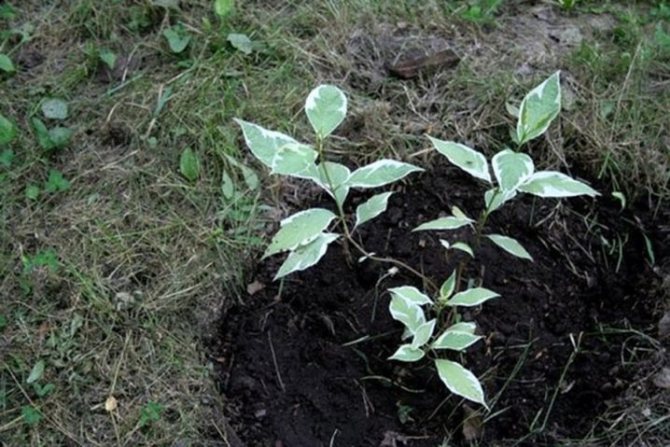

It is best to use seedlings up to 4 years old, obtained from cuttings, as the main planting material. In this case, the young plant will fully acquire all the features and characteristics of the mother plant. Only healthy seedlings should be planted without visible damage to the root system and stem. The foliage should be rich in color. If the roots of the tree are windy, then before planting they should be placed in a bucket of water for several hours. If desired, you can add a little root stimulant solution.
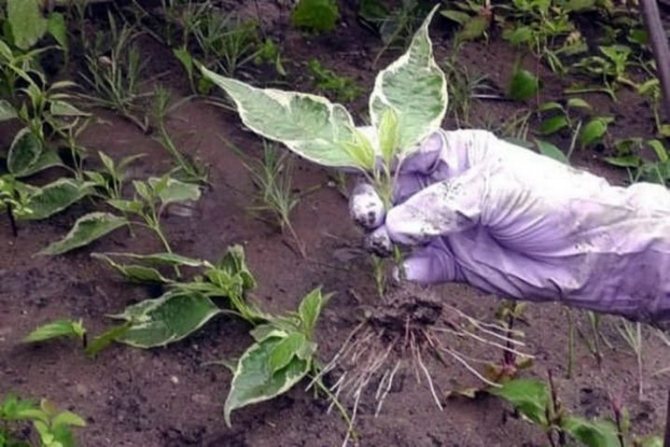

The planting procedure is as follows.
- The topsoil should be removed from the plot of land where the turf is planned to be planted. The removed soil is mixed with sand and humus in equal proportions.
- Then fertilizers are applied. It is best to take granular combination preparations at the rate of 100 g per 1 sq. m. plot.
- The pit is usually made large and deep. If the soil is swampy, then a layer of brick or medium-sized stones must be placed on the bottom.
- The bottom of the planting pit is covered with humus and sand and about 5-7 liters of water are poured into it.
- The seedling is placed in the hole, the roots are gently straightened and covered with the prepared soil mixture to the level of the root collar. If it is located too high, then the bush will give too many weak shoots, which will inevitably lead to the death of the plant.
- For group planting, a distance of 1.5 m should be observed between the bushes.
- After the end of planting, the earth is tamped, the surface is covered with mulch from sawdust, pine needles and peat.
Watering rules
It is quite simple to care for the lawn, watering is done only once a month, but it is voluminous, about two buckets per plant. In hot summer, in the absence of rain, you can increase watering as needed, and also decrease during high humidity.
Newly planted plants require more frequent watering for 2-3 years.
To ensure the decorative effect of the shrub, it needs fertilizers. It is enough to apply two times the application of mineral fertilizers per year, as well as the addition of organic matter in the summer. From organic compounds, you can use compost or humus.
Why do the leaves of the variegated deer turn black and dry
Very often, gardeners are faced with a problem when the leaves of Derain variegated begin to dry out and become covered with black dots. These symptoms indicate that the bush has undergone a fungal disease. To combat rot, the following drugs are used:
- "HOM";
- "Vectra";
- "Topaz".
It is recommended to reduce the number of waterings during processing. Also, black spots on the leaves appear when Derain variegated is watered with cold water.
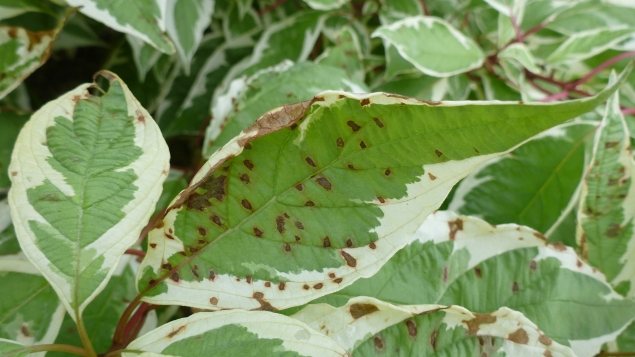

How to trim properly
Among landscape designers, variegated dogwood is one of their favorite crops - it can become the central object of the site, fit into any park ensemble.
This extraordinary shrub can be cut into many different shapes. The laborious pruning process takes place twice a year - in the spring and late summer. First, it is necessary to remove old lifeless branches, as well as excess growth by cutting. The stems sticking out in the wrong direction are also removed.
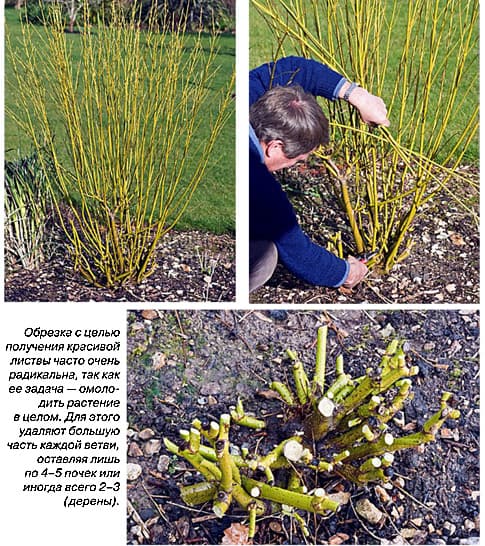

The shrub easily tolerates cutting, new stems grow at an enviable speed in the place of remote shoots.
For arranging arches, decorating gates, creating even landings at fences, trimming is achieved to obtain columns, arcs, spheres and hemispheres, as well as all kinds of geometric shapes.
In order to avoid overgrowing to other areas of the estate, forming pruning is done necessarily and regularly. Giving a beautiful, original shape to the lawn will make the site look unique.
Description and popular varieties
The leaves of the deren are 5-6 cm in size. They are opposite in type, elliptical in shape. Veins are visible on the surface. Above the leaves are dark green in color, below - gray.The flowers of the shrub are small, they are collected in compact inflorescences. Derain white variegated blooms 2 times: in June and September. The shrub also bears fruit - blue drupes that resemble berries.
Garden culture begins to bear fruit from the age of three. White dogwood is appreciated for its decorative effect and shade tolerance. The plant tolerates cold weather normally. Derain grows well if planted in fertile soil. The shrub is unpretentious to care for.
Several varieties of plants are cultivated in horticulture. Most requested:
- Derain white Argenteo-marginata. The bark of this plant is red, the leaves are rich green with a light rim. Argenteo-marginata changes color in autumn. The foliage turns dark.
- Elegantissima. If you do not correct this shrub, it will reach a height of 3 m. The plant has beautiful wide branches, its leaves are green with a cream border and characteristic spots.
- Siberia. This shrub is undersized. It has red shoots and light green foliage. The variegat variety grows 1.7 m. The border of the leaves is beige with characteristic strokes. The foliage turns purple in autumn.
- Derain white Aurea. The plant is distinguished by yellowish leaves. Its shoots are red, the flowers are cream.
- Derain white Shpet. The horticultural crop has brownish-red shoots. The border of the leaves is original, uneven.
Derain variegated, varieties of which differ in color of leaves, are planted separately. The plant looks great as a hedge.
Top 5 most popular types of turf
Dogwood (Cornus alba). The most common type and the undoubted leader in popularity for use in landscape design. In good conditions, the bush can reach up to 3 meters in height and width. Dogwood has erect shoots of dark red or scarlet color, depending on their age. Along with the color of the shoots, the color of the foliage is remarkable - green large leaves will turn purple-burgundy in autumn. And the beautiful white caps of inflorescences, pleasing to the eye from May to June, by autumn will turn into clusters of blue-white berries.
For more than a hundred years, breeders have been working on breeding variegated varieties of svidina on the basis of this very tenacious and winter-hardy species. The most famous fruits of their labors are ‘Elegantissima’, ‘Sibirica’, ‘Sibirica Variegata’ and ‘Aurea’ - these varieties of variegated turf are widely used in landscape design.
- The ‘Elegantissima’ variety is characterized by the presence of a wide white border on the bluish-green leaves of the shrub. The sprawling 'Elegantissima' turf shrub 2.5 meters tall with red shoots really looks elegant and will be the perfect tapeworm in your area.
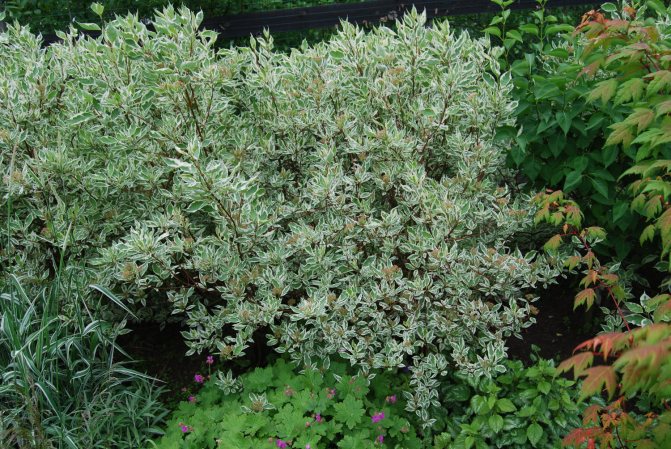

Doren Elegantissima - ‘Sibirica’ and ‘Sibirica Variegata’ are not tall (about 1.5 meters) by the standards of turf, which can boast of a discouraging brightness of the shoots: their color is coral red, very rich. 'Sibirica Variegata' differs from its relative by the presence of a snow-white border and stripes on the leaves.
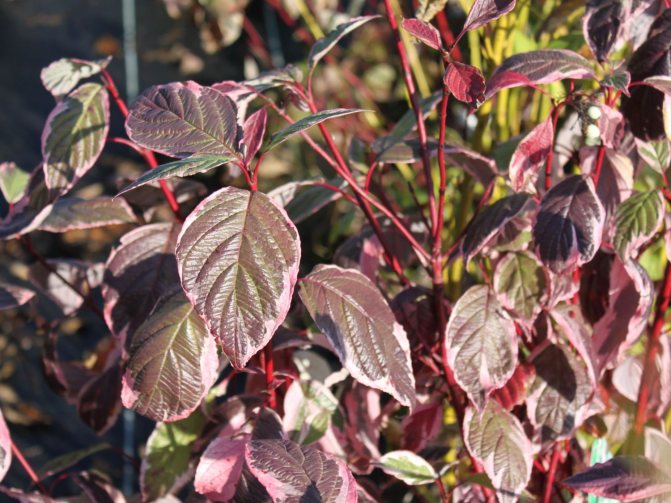

Dogwood Sibirica Variegata - ‘Aurea’ is the strain for fall lovers. The two-meter bush will delight you with yellow foliage on red branches all summer long, you don't have to wait for September to admire its colors!
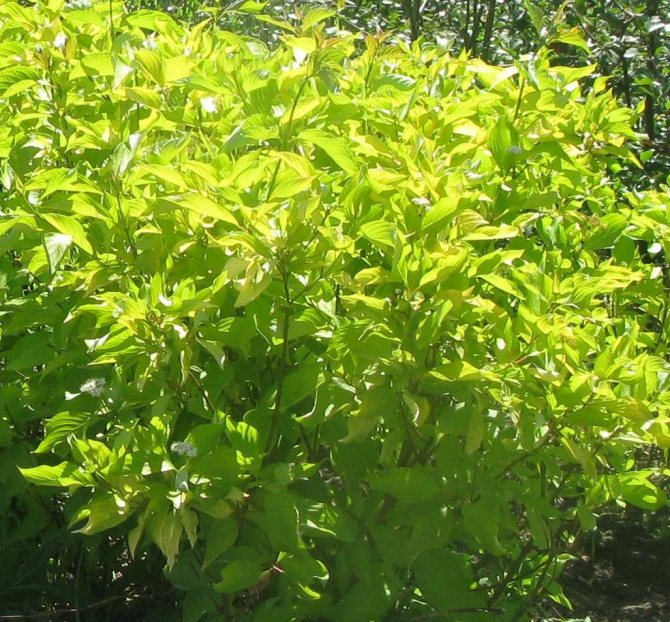

Dogwood Aurea
It should be noted that any variegated dogwood will reveal its qualities much better only in a well-lit place. In shading, the leaves of the plant will produce more chlorophyll than other pigments and they will turn green.
Dogwood red (Сornus sanguinea), or blood-red dogwood, is common throughout Europe and resembles white dogwood. But this species is much higher (up to 4 m, according to some sources - up to 7 m), has larger leaves, drooping shoots of various colors, depending on the variety. It got its name for its autumn dress - huge blood-red leaves, decorated with small blue-black berries.
It is a pity that such a handsome man will not grow in our harsh Siberia, it is best to grow it within its natural range.
Сornus sanguinea
Dogwood (Cornus canadensis) is widespread in North America and the Far East, it can be found even in Greenland and the Japanese islands. Canadian dogwood in landscape design is used as a ground cover plant in compositions, rockeries and to create a shrub lawn.And we understand why, because its life form is a dwarf half-shrub only 20 cm high with herbaceous stems and large elongated leaves. Unlike other dogwoods, it grows slowly. The flowers of the Canadian svidina are subtle, but the bracts, large and white, give the impression of large single flowers on the plant from June to July. Scarlet berries ripen in August. They enliven the green carpet with bright splashes.
Dogwood canadian
For this shrub, a semi-shady place with moist acidic soils will be ideal. Well, you should not worry about winter hardiness - thermophilic species do not survive in Greenland. The main thing is to sprinkle it with better snow. In their natural environment, these plants live in snowy areas.
Japanese dogwood (Cornus kousa) is sometimes also called Benthamidia kousa and Cynoxylon kousa. The birthplace of bentramia is China and Japan. In nature, it grows in the form of a small deciduous tree or a tall shrub 5-7 meters high. Like the Canadian turf, in this species the bracts play the role of petals.
Dogwood Japanese
The peculiarity of Japanese turf is that its dark pink fruits are visually similar to raspberries, but are valued only for their decorative effect. "Raspberries" look very pompous on a tree in autumn against the background of bright red foliage and can become an excellent tapeworm or accent of a decorative group.
Japanese dogwood will feel good only in the south of Russia, in the middle lane the bush will require shelter for the winter.
The enterprising Japanese have learned to grow dogwood as a bonsai-style houseplant. Therefore, if you really liked this particular type of turf, and you do not live in Sochi, look for a good master of the art of bonsai.
Shooting dogwood (Cornus stolonifera) is similar in appearance to white dogwood. The shoot-bearing dogwood is distinguished by a large looseness of the bush and continuous vegetative reproduction by offspring. The lower branches, approaching the ground, quickly root and the bush grows strongly in breadth.
A couple of varieties of this restless species deserve special attention: ‘Koralle’ and ‘Cardinal’. They are both curious with their yellow bark. The ‘Koralle’ is much taller than ‘Cardinal’ (up to 2.5 meters), bears fruit with black berries, so beloved birds, and boasts bright yellow shoots all year round.
But the shoots of the ‘Cardinal’ variety are yellow-green in summer, but by winter they will acquire red shades. The berries of this shrub are white and inedible even for birds, the shoots rise only a meter from the ground. Therefore, it is often used specifically for low, up to a meter, hedges - free or molded.
I have described only a few species and a very small number of svidina varieties. Breeders have bred so many of them that you can't throw them out the window in a day, as they say. Therefore, you can find for yourself a lot of bold, elegant and reliable design solutions using the beloved turf.
When to trim?
Before you start forming a variegated turf bush, you need to know how to choose the right time.
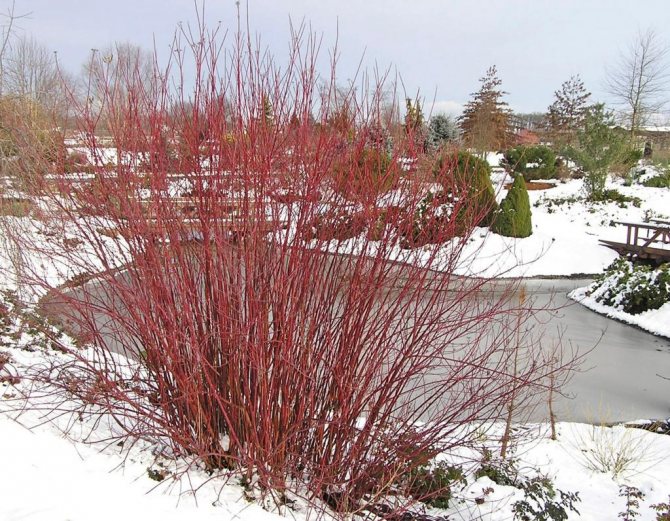

Decorative pruning is done twice a season - in early June and late July. In the summer, the green mass (foliage and branches) is actively growing, so the planned silhouettes are violated - it is necessary to take measures to return the bushes to their original shape.
Radical pruning (anti-aging) is usually performed in the fall when the sap stops moving.
Finally, sanitation can be carried out at any time - as needed.
Place in landscape design
The variegated variety of turf is an adornment of any estate, requiring not so much attention to its person.
The shrub is planted as a hedge and given a special shape. Perfectly fits into the composition with juniper, barberry, rose bushes.
With flowering plants, undersized and medium-sized shrubs, even with coniferous individuals, the lawn will look spectacular.
Bushes planted along the barriers will set the tone for the entire site, being a kind of contour.
With the help of variegated sod, you can designate the zoning of the territory. Another indisputable advantage is that on a mowed lawn or in a rocky garden, a bush can become a landmark. After all, this perennial unassuming shrub is also good in a single planting.
Variegated Derain will decorate any garden, its bright, edged leaves, combined with the unusual color of the bark, make the plant unusually decorative. Planting a shrub should be provided in a free area of the garden - the lawn grows very quickly, the free space around the bush makes it more convenient to periodically inspect the plants and care.
Outdoor cultivation
You do not need to have any special skills to plant white turf. The plant is planted in March or late autumn. Most often they practice autumn planting. In the spring, seedlings that have undergone wintering can actively grow, which is not very good. Garden culture is placed in partial shade. You can plant it near the trees.
Teren is used in landscape design. It makes a great hedge. The shrub is planted along the fences. If a variegated variety is chosen, it must be placed in the sun, otherwise it will lose its decorative effect.
Read also: Apricot: varieties
The variegated turf shrub does not impose high requirements on the composition of the soil, but prefers light sandy soil. The plant takes root in loam. It is recommended to plant it in soil with a neutral acidity level. A plant that is 3 years old is ideal for planting. It quickly takes root in the open field and gives a large number of shoots that can be used for propagation.
Before placing the seedling in open ground, you need to hold it in water for 4 hours. This will make the roots stronger. If the seedling has a closed root system, it does not need to be placed in water. For planting, a trench is dug, it should be 1/3 more than an earthen coma.
If the plant is planted in a swampy area, good drainage should be provided.... For its preparation use:
The components, taken in equal proportions, are placed at the bottom of the trench. The optimal layer thickness is 15 cm. If there is no groundwater nearby, you can do without drainage or lay only sand. In order for the shrub to grow well in the open field, it is necessary to prepare a soil mixture from compost and humus. After planting, the soil is compacted and water is added. You will need to mulch using peat. The root collar is placed 1 cm above the ground.
Landing
Planting variegated turf does not cause any particular difficulties: it is undemanding, it grows well on soils of different types. The main thing is that it is not waterlogged, in such cases it is necessary to provide additional drainage.
Seat selection
Fertile soil is considered ideal, but sandy or clay soil is also suitable. The main condition is the occurrence of groundwater at a depth of at least 1.5 m. Otherwise, high humidity will lead to diseases of the root system.
Sunlight requirements are not stringent. The bushes grow well both in direct sunlight and in partial shade.
Please note: there are several varieties for which insufficient lighting is undesirable. Growth deteriorates, and the color becomes monotonous. This is especially true for species with bright colors.
The place of disembarkation is determined by expediency. If you plan to create a hedge, then you need to plant "heap". In such cases, varieties with erect stems are suitable. For compositional design, it is better to choose undersized species with spreading branches.They perfectly decorate trees, the crown of which is located at a height (the main thing is that the crown does not greatly shade the bushes growing below). This will require space for growth and formative pruning. For a solo landing, space is needed. To make the overgrown shrub look spectacular, leave an area for it with a diameter of up to 3 meters.
Choose a planting site in advance, taking into account the characteristics of the selected variety. Adult specimens do not tolerate transplantation well. It is done only in the most extreme cases, keeping an earthen lump, only in early spring or late autumn. Carefully transferred shrubs need to be watered and mulched with peat chips. The main reasons for transplanting are a threat to other plants due to an overgrown root system. Or the gradual loss of the main varietal traits and wilting.
Boarding time
The best time for planting is spring. By the time the soil and air warms up, you need to prepare the soil. Seedlings are more sensitive to temperature conditions, they need time to adapt and more attentive care. The optimum air temperature is +12 - 150, for the ground - from 10 and above, and at a depth of at least 12 centimeters.
Please note that disembarkation is not recommended in the fall. It takes time for the seedlings to take root and winter well.
How to plant
After choosing a place, you must:
- prepare a landing pit 65 cm deep and 50 cm in diameter (or a ditch if you plan to make a hedge);
- waterlogged soil should be drained;
- organic fertilizers are added to the pit (humus or compost, up to 10 kg in each pit);
- before planting, it is better to moisten the dried roots: for this, you should put it in a bucket of water so that the roots are saturated with moisture.
Actually, this is where the preparation ends. The seedlings are fixed in the ground, for this, the earth is poured, and the seedling itself is shaken a little to fill the voids. The distance should be at least 1.5 - 2 meters, the exception is the creation of a hedge, then it is reduced by three to four times.
The root collar should be above the surface at the level of 2-3 cm. With a strong deepening, the seedling will die, if less buried the shoots will be weak.
After planting, each hole should be watered (with warm water, about 20 liters will be required), after planting, gently loosen and mulch the soil.
To strengthen the root system as soon as possible, you can treat it with gruel from fresh cow dung and powdered clay diluted with water. For a single planting, a peg can be installed for support (the length should be 20 cm longer than the seedling). It is stuck to the bottom of the pit at a short distance.
How to choose a seedling
For rooting and good growth, you need to choose seedlings not older than 4 years. The taproot must be at least 20 cm in size, without rotten processes. The root system of healthy specimens is flexible and elastic, the bark of the stems is smooth and uniform.
Young animals should be fed with mineral fertilizers. It is better to alternate root dressing with foliar. The first wintering in a particularly harsh climate is best done soft: it should be covered with breathable materials. But it is not necessary to insulate too much, an excess of heat will lead to damping.
Types of pruning
All types of autumn pruning are conventionally divided into two groups: sanitary
and
formative
... Another view -
rejuvenating
, performs both functions both to heal the bush and to give it the desired shape. The decorativeness, appearance and intensity of flowering of the garden in the next season depends on the quality and timeliness of the work carried out.
Autumn formative pruning is not permissible for all bushes, but only for summer flowering ones. Having cut off spring-flowering plants in the fall, there is a risk of getting a minimum of decorative effect from shrubs in the spring, since they bloom on last year's shoots. This type includes:
- forsythia;
- chubushnik;
- large-leaved hydrangea;
- heenomeles (Japanese quince);
- weigela;
- bladderworm;
- three-lobed almonds;
- lilac;
- all white-flowering varieties of spirea (Vangutta, ash, Nipponskaya, Arguta, Thunberg, etc.);
- barberry Thunberg;
- action;
- bean (steppe almond), etc.
These types of shrubs are subjected to sanitary and rejuvenating pruning in the fall, but in no case are they formed. Carrying out the rejuvenation of such bushes, branches older than five years of age are removed and only those shoots that clearly thicken the bush.
Formative pruning
The group of shrubs that need not only sanitary, but also formative autumn pruning is no less extensive and requires a very careful approach, since its flowering and decorativeness in the following summer largely depends on the timely and well-executed formation of the crown of the bush. These include:
- treelike and paniculate hydrangeas;
- fieldfare;
- Japanese spiraea, Bumalda, Macrophylla, Frebel;
- panicle spirea (Billard, Douglas, willow);
- buddley of David;
- shrub cinquefoil (Kuril tea);
- white derain, etc.
Buddlea
- a shrub with an overground part dying off for the winter. Therefore, it makes no sense to keep it in winter. Only buds on the root collar overwinter. Therefore, the buddley is cut off to a height of twenty centimeters under the shelter.
Mountain ash
, which looks like a large overgrown astilba, practically does not need to be formed, its faded panicles are cut off in the fall, cutting off the shoots to the strongest bud, the cut is made at an angle to avoid moisture accumulation. The pruning height for this shrub does not really matter, therefore it is selected solely based on design considerations.
Derain white
- a variegated handsome man with an unusual beet-red color of the bark. The flowering of this shrub is not of particular value, it is completely inconspicuous against the background of gorgeous foliage. Therefore, the sod is pruned to form the desired crown. This shrub grows quite quickly, during the season it can give an increase of up to one and a half meters, it will not cause much trouble. In the fall, all old branches are cut out, more than five years old. In the spring, the bush will drive powerful vertical shoots from the root. If the goal is to get a "shaggy" rounded bush, then in the fall it is recommended to prune the one-year growth by two or three buds, which will accelerate their lateral branching in the spring. If you plan to admire the bright picturesque branches against the background of snow, then it is better to leave the annual shoots intact - they have the brightest color of the bark.
Shrub Potentilla (Kuril tea)
itself has the correct crown shape, therefore, it undergoes strong pruning only when the bush is deformed (collapsed). Under normal development in the fall, unrooted shoots are cut to a length of up to twenty centimeters, old and damaged branches are cut out.

